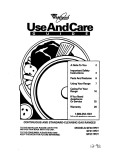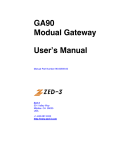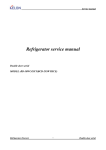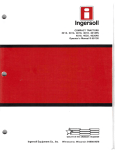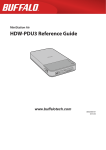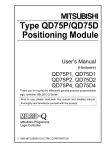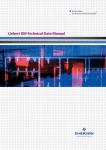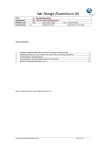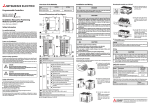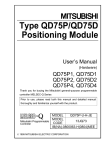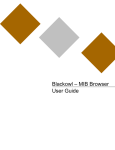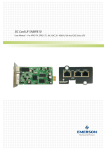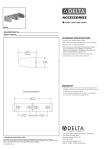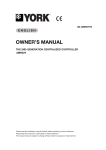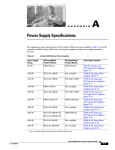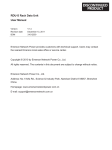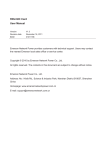Download Liebert RDU-A User Manual
Transcript
IRM-U06ID RDU-A Intelligent Monitoring Unit User Manual Version V2.3 Revision date July 24, 2012 BOM 31012629 Emerson Network Power provides customers with technical support. Users may contact the nearest Emerson local sales office or service center. Copyright © 2012 by Emerson Network Power Co., Ltd. All rights reserved. The contents in this document are subject to change without notice. Emerson Network Power Co., Ltd. Address: No.1 Kefa Rd., Science & Industry Park, Nanshan District 518057, Shenzhen China Homepage: www.emersonnetworkpower.com.cn E-mail: [email protected] Contents Chapter 1 Introduction ......................................................................................................................................................... 1 1.1 Characteristics ...................................................................................................................................................... 1 1.2 Component Descriptions ....................................................................................................................................... 1 1.2.1 RDU-A Host ............................................................................................................................................... 1 1.2.2 Power Module............................................................................................................................................ 4 1.2.3 IRM-E04COM Board (Optional) ................................................................................................................. 5 1.3 Main Functions...................................................................................................................................................... 5 1.4 Technical Specifications ....................................................................................................................................... 6 1.4.1 Safety Regulations And EMC .................................................................................................................... 6 1.4.2 Environment Specifications ....................................................................................................................... 6 1.4.3 Mechanical Specifications ......................................................................................................................... 7 1.4.4 Performance Specifications ....................................................................................................................... 7 Chapter 2 Hardware Installation .......................................................................................................................................... 8 2.1 Installation Preparation ......................................................................................................................................... 8 2.1.1 Note ........................................................................................................................................................... 8 2.1.2 Environmental Requirement ...................................................................................................................... 8 2.1.3 Heat Dissipation Requirement ................................................................................................................... 8 2.1.4 Installation Tool ......................................................................................................................................... 8 2.2 Installing IRM-E04COM Board .............................................................................................................................. 9 2.2.1 Set Communication Mode Of COM5 ~ COM8 ........................................................................................... 9 2.2.2 Mechanical Installation .............................................................................................................................. 9 2.3 Installing RDU-A Host And Power Module ............................................................................................................ 9 2.3.1 Set Communication Mode Of COM1 ~ COM3 ........................................................................................... 9 2.3.2 Mechanical Installation ............................................................................................................................ 10 2.3.3 Electrical Connection ............................................................................................................................... 12 2.4 Installing Sensor ................................................................................................................................................. 12 2.4.1 Installing Intelligent Sensors .................................................................................................................... 12 2.4.2 Installing Physical Sensors ...................................................................................................................... 14 Chapter 3 Access RDU-A Through Interfaces................................................................................................................... 15 3.1 Logging On RDU-A ............................................................................................................................................. 15 3.1.1 Through Network Port (LAN) ................................................................................................................... 15 3.1.2 Through Console Port (CONSOLE) ......................................................................................................... 17 3.2 Power On RDU-A................................................................................................................................................ 19 3.3 Using Command Line ......................................................................................................................................... 19 3.3.1 Logging On To The Command Line ........................................................................................................ 19 3.3.2 Setting RDU-A User Password ................................................................................................................ 19 3.3.3 Setting IP Address Of RDU-A .................................................................................................................. 19 3.3.4 Set Time Of RDU-A ................................................................................................................................. 20 3.3.5 Reboot RDU-A......................................................................................................................................... 20 Chapter 4 Access RDU-A Through Web ........................................................................................................................... 21 4.1 Overview Of Web Function ................................................................................................................................. 21 4.2 Authorizing Boot-Strap Page............................................................................................................................... 21 4.3 Login RDU-A Web Page ..................................................................................................................................... 22 4.4 Getting Password Page ...................................................................................................................................... 23 4.5 RDU-A Homepage .............................................................................................................................................. 23 4.6 Menu ................................................................................................................................................................... 24 4.6.1 Data Center ............................................................................................................................................. 24 4.6.2 AC TeamWork ......................................................................................................................................... 30 4.6.3 Alarm Options .......................................................................................................................................... 34 4.6.4 Data & History ......................................................................................................................................... 41 4.6.5 Device Options ........................................................................................................................................ 42 4.6.6 System Options ....................................................................................................................................... 48 4.6.7 Personal Setting ...................................................................................................................................... 55 4.7 Shortcut Method.................................................................................................................................................. 56 4.7.1 Modifying Signal Name ............................................................................................................................ 57 4.7.2 [User] Logout ........................................................................................................................................... 57 4.7.3 Controllable Status .................................................................................................................................. 57 4.7.4 Time Calibration Link ............................................................................................................................... 58 4.7.5 View By Location ..................................................................................................................................... 58 Chapter 5 RDU-A Configuration ........................................................................................................................................ 60 5.1 RDU-A Configuration Method ............................................................................................................................. 60 5.2 RDU-A Configuration Demonstration .................................................................................................................. 61 Chapter 6 Maintenance ..................................................................................................................................................... 65 6.1 Recovering Default Setting ................................................................................................................................. 65 6.2 FAQ .................................................................................................................................................................... 65 Appendix 1 Abbreviation ................................................................................................................................................... 72 Appendix 2 Standard Configuration List ............................................................................................................................ 73 Chapter 1 Introduction Chapter 1 Introduction IRM-U061D RDU-A intelligent monitoring unit (RDU-A for short) supplies flexible monitoring solutions for data centers. This chapter expounds characteristics, component descriptions, main functions and technical specifications of RDU-A. 1.1 Characteristics RDU-A has the following characteristics: Supporting connection of intelligent sensor modules from our company Supporting connection of equipment from our company and third party for extension Supporting online adding, deleting and modifying equipment Supplying notifying function of alarm in real time, and reminding users timely Supporting SNMP protocol to connect intelligent equipment for extension Having simple programmable logic controller function to map alarms Supporting remote service function Supporting AC teamwork function 1.2 Component Descriptions RDU-A includes RDU-A host, power module IRM-U061DR1 (power module for short) and IRM-E04COM board (optional). 1.2.1 RDU-A Host The appearance and interfaces of RDU-A host are shown in Figure 1-1. Power indicator Alarm indicator Front view IRM-U061D RDU-A Intelligent Monitoring Unit User Manual 1 2 Chapter 1 Introduction 17 16 10 11 12 13 14 15 9 1 4 2 5 6 7 8 3 1.Indicators 2.PE 3.Power port 4.Network port 5.Console port 6.USB port 7.Relay output port 2 8.Relay output port 1 9.Expansion slot 10.Door status 1 port 11.Door status 2 port 12.Smoke port 13.Sensor port 14.COM 2 15.COM 3 16.COM 1 17.Water port Rear view Figure 1-1 Appearance and interface Indicators There are two indicators on the front panel of the RDU-A host, as shown in Figure 1-1. See Table 1-1 for their definitions. Table 1-1 Definition of Indicators in the front panel Silk print Definition Color POWER Power indicator Green ALARM Alarm indicator Red Status On Off On Off Blinking slowly (about 0.5Hz) Blinking quickly (about 4Hz) Definition The RDU-A host is powered on The RDU-A host is powered off Critical alarm No alarm Observation alarm Major alarm There are nine indicators on the rear panel of the RDU-A host, of which two indicators are reserved. Their positions are shown in Figure 1-1. See Table 1-2 for their definitions. Table 1-2 Definition of Indicators in the rear panel Silk print Definition Color POWER Power indicator Green ALARM Alarm indicator Red SLOT Slot indicator Green Status On Off On Off Blinking slowly (about 0.5Hz) Blinking quickly (about 4Hz) On Off Blinking quickly (about 4Hz) SENSOR COM1 ~ COM3 Sensor port indicator COM port indicator Green Green Blinking Off Blinking Off IRM-U061D RDU-A Intelligent Monitoring Unit Definition The RDU-A host is powered on The RDU-A host is powered off Critical alarm No alarm Observation alarm Major alarm The board inside the slot is normal No board is inside the slot or the inside board is abnormal Detecting the board status automatically while starting up Data received and sent No data received or sent Data received and sent No data received or sent User Manual Chapter 1 Introduction 3 Network port The RDU-A host supplies a network port, which adopts 10/100M self-adaptable Ethernet port. Its position is shown in Figure 1-1. Console port The RDU-A host supplies a console port (RJ45 interface, see Figure 1-1 for its position), which adopts RS-232C communication mode. The communication parameters are given in Table 1-3. Table 1-3 Communication parameters of console port Parameter Value Baud rate 115200bps Bit 8 bits Parity None Stop bit 1 bit USB port The RDU-A host supplies a USB port for connecting camera or USB Modem of designated model. Its position is shown in Figure 1-1. Relay output port The RDU-A host supplies two relay outputs. Their positions are shown in Figure 1-1. See Table 1-4 for their parameters and Table 1-5 for phase sequences of the RJ45 interface. Table 1-4 Relay output port parameter Parameter Route Value 2 Relay output contact (normally-open/normally-closed optional) 0.75A/30Vdc Output contact Contact capability Description Two relays can be controlled independently, totally supplying +24Vdc/0.2A power output Table 1-5 Phase sequences of relay output port (RJ45 interface) Phase sequence1 Definition 1 2 24V 24V 3 Normallyclosed 4 GND 5 Common end 6 Normallyopen 7 8 2 NC NC Note: 1. The phase sequences of RJ45 interface are 1 to 8 from left to right, with the gap downwords; 2. NC: Not Connected Digital signal port The RDU-A host supplies four digital signal ports. Their positions are shown in Figure 1-1. See Table 1-6 for their parameters and Table 1-7 for phase sequences of the RJ45 interface. Table 1-6 Digital signal port parameter Silk print Definition Interface type Measured signal Power output Maximum output current DOOR1 Door status 1 port DOOR2 Door status 2 port 0.4A (the total RJ45 interface Dry contact + 24Vdc current of 4 inputs) WATER Water port SMOKE Smoke port Note: These ports are all default configurations, which can also be configured as other sensor’s connecting mode through software configuration by maintenance engineers only Table 1-7 Phase sequences of digital signal port (RJ45 interface) Phase sequence Definition 1 24Vsignal input+ 2 24Vsignal input+ 3 Signal input(GND) 4 5 GND GND IRM-U061D RDU-A Intelligent Monitoring Unit 6 Signal input(GND) User Manual 7 Signal input(GND) 8 Signal input(GND) 4 Chapter 1 Introduction Sensor port The RDU-A host supplies a route of sensor port, including two RJ45 interfaces. Their positions are shown in Figure 1-1. Adopt RS-485 communication mode, see Table 1-8 for its communication parameters Table 1-8 Communication parameters of sensor port Parameter Value Baud rate 9600bps Bit 8 bits Parity None Stop bit 1 bit Dedicated interface for temperature & humidity sensor, temperature sensor and digital expansion module Supply 24Vdc for connected sensor Up to 25 sensors can be connected COM port The RDU-A host supplies three independent COM port, namely, COM1, COM2 and COM3. Their positions are shown in Figure 1-1. Their communication modes are all RS-485/RS-232C, which can be chosen by jumper settings. See Table 1-9 and Table 1-10 for their communication parameters and phase sequences of the RJ45 interface. Table 1-9 Communication parameters of COM port Parameter Value Baud rate 1200bps, 2400bps, 4800bps, 9600bps, 19200bps (optional) Bit Parity Stop bit 6 ~ 8 bits Even/Odd/None 1 ~ 2 bits Table 1-10 Phase sequences of COM port (RJ45 interface) Phase sequence Definition 1 RTS 2 NC 3 TXD 4 GND 5 GND 6 RXD 7 D+ 8 D- Isolated from each other, not hot-pluggable 1.2.2 Power Module The RDU-A has a dedicated power module. Its appearance is shown in Figure 1-2. Figure 1-2 Power module The power module can only be used for RDU-A products. Its AC end adopts common power cable, the input voltage is 100Vac ~ 250Vac and the input frequency is 45Hz ~ 65Hz; its DC end adopts Phoenix terminal. The power module supplies two DC outputs, and the output voltage is 24Vdc. Its total power is 30W. Note It is prohibited to open the shell of the power module. IRM-U061D RDU-A Intelligent Monitoring Unit User Manual Chapter 1 Introduction 1.2.3 IRM-E04COM Board (Optional) IRM-E04COM board supplies four COM ports (COM5 ~COM8), which are used to connect user equipment. Its appearance is shown in Figure 1-3. Jumper J9 ~ J11 Jumper J5 ~ J7 Jumper J1 ~ J3 Jumper J13 ~ J15 Indicator COM5 ~ COM8 Figure 1-3 IRM-E04COM board See Table 1-11 for the indicator definitions of IRM-E04COM board. Table 1-11 Indicator definitions of IRM-E04COM board Silk print Definition Color POWER Power indicator Green COM5 ~ COM8 COM port indicator Green Status On Off Blinking Off Description The IRM-E04COM board is powered on The IRM-E04COM board is powered off Data received and sent No data received or sent 1.3 Main Functions The main functions of RDU-A are listed in Table 1-12. Table 1-12 Main functions of RDU-A Main function Device monitoring AC TeamWork Alarm Options Description Realizing camera viewing in data center; getting and handling the data of different intelligent devices and controlling them through Web interface Monitoring and controlling each AC which participates in the AC teamwork according to a certain rule, to achieve the goals of reducing AC power consumption, prolonging AC life-span and avoiding competition among ACs in the team Current alarm Displaying alarm in real time, and confirming the current alarm History alarm Querying the history alarm 1. Can be customized according to user requirements, that is, alarm notification content can be customized; 2. You can choose the communication mode to receive alarm information of different level from different equipment; Alarm notification 3. The communication mode includes Email, SMS and phone; 4. Email supports SSL function; 5. Supplying alarm test function to test whether or not users have received the alarm notification information; 6. Sending the system running status periodically according to user configuration 1. Can be customized according to user requirements; 2. REKAY1 alarm output; 3. Can combine equipment signals, parameters and alarm to control equipment; 4. Having the following logic components: Actions 1) AND, which represent AND command 2) OR, which represent OR command 3) NOT, which represent NOT command 4) XOR, which represent XOR command 5) GT, which represent GT command 6) LT, which represent LT command 7) DS, which represent DS command IRM-U061D RDU-A Intelligent Monitoring Unit User Manual 5 6 Chapter 1 Introduction Main function Data & History Description Device information History data History log Clear history Device management Device Options Signal setting Batch configuration Monitoring unit Network setting System Options Personal Setting User management Date/time setting System reset Site setting System upgrade System title Status bar Querying the main data of equipment Querying the history data Querying the log data Clearing the history data and log data 1. Can add, modify and delete equipment actively, and support adding seven pieces of intelligent equipment at most; 2. Can install and uninstall equipment type and support connecting third party equipment Modifying equipment name, signal name and alarm level online Updating and downloading configuration files and system files Collecting the system information of RDU-A 1. Setting the network information such as IP, subnet mask, gateway and DNS; 2. Controlling whether the upper monitoring system (RDU-M manager) can visit the RDU-A; 3. Remote service setting Adding, modifying and deleting user information Calibrating the real time clock of RDU-A Rebooting the RDU-A and restoring default configuration Modifying site information online Upgrading the application program online Setting title and logo picture at the top of the Web page Configuring the current display contents of the status bar 1.4 Technical Specifications 1.4.1 Safety Regulations And EMC See Table 1-13 for the safety regulations and EMC of RDU-A. Table 1-13 Safety regulations and EMC Item Description Safety regulations EMC EN60950, UL60950 (CE) EN 55022:2006, IEC61000-4-6: 2006 1.4.2 Environment Specifications See Table 1-14 for the environment specifications of RDU-A. Table 1-14 Environment conditions Item Application location Working temperature Relative humidity Working environment Air pressure Storage temperature Cooling Power distribution network Protection level Requirement Usually in data center or computer room, with air conditioner -10ºC ~ +50ºC 5%RH ~ 95%RH, no condensing Dust: compliant with the indoor requirements of GR-63. No corrosive gas, flammable gas, oily mist, steam, water drops or salt 70kpa ~ 106kpa -40ºC ~ +70ºC Natural cooling TT/TN IP20 IRM-U061D RDU-A Intelligent Monitoring Unit User Manual Chapter 1 Introduction 1.4.3 Mechanical Specifications See Table 1-15 for the mechanical specifications of RDU-A. Table 1-15 Mechanical specifications Components RDU-A host Power module IRM-E04COM board Size (L × W × H, unit: mm) 483.0 × 286.0 × 40.3 198.2 × 108.0 × 42.6 122.0 × 180.0 × 20.0 Weight (unit: kg) ≤5 ≤1 ≤ 0.5 1.4.4 Performance Specifications See Table 1-16 for the performance specifications of RDU-A. Table 1-16 Performance specifications Connected component Connecting nodes of DI, SENSOR ports Acousto-optic alarm indicator Intelligent device Cable standard Connected distance (unit: m) Connected number / connection point ≤ 100 28[1] ≤ 100 2[2] ≤ 100 16[3] Standard category 4 twisted-pair cable Standard category 4 twisted-pair cable Standard category 4 twisted-pair cable Note: [1]: For temperature, temperature and humidity, door status, water, 4DI, 4DO sensors, DO devices and so on, each sensor or device is calculated as one node; for smoke and infrared sensors, each sensor is calculated as four nodes; [2]: The acousto-optic alarm indicator has two routs of connection points: RELAY1, RELAY2, which can be used as two routes of digital output for other use; [3]: The RDU-A can connect up to 16 intelligent devices, not including the default devices. The devices connected through network mode cannot exceed eight, and the connected devices of single COM cascade cannot exceed four IRM-U061D RDU-A Intelligent Monitoring Unit User Manual 7 8 Chapter 2 Hardware Installation Chapter 2 Hardware Installation This chapter introduces the hardware installation of RDU-A, including installation preparation, installing IRM-E04COM board, installing RDU-A host and power module and installing sensor. 2.1 Installation Preparation 2.1.1 Note To ensure the safety of the product and installation personnel, take the following precautions: Always cut off the power before performing any installation operation Ensure that the peripheral equipment are connected to the correct RDU-A ports The IRM-E04COM board is not hot-pluggable, if it is plugged into the serial port when power is on, it cannot work normally Wear an ESD wrist-wrap when installing the IMU6100 Arrange the wires properly, and do not put any heavy objects on the wires or stamp the wires 2.1.2 Environmental Requirement Operating environment The RDU-A must be installed indoors. See Table 1-14 for the detailed requirements. Anti-static requirement Take the following measures for minimizing static influences: Maintain proper temperature and humidity in the room (See Table 1-14) Wear antistatic clothing and an ESD wrist-wrap when operating the RDU-A; if antistatic clothing or ESD wrist-wraps are unavailable, wash your hands and dry them instead, which helps discharge the static electricity Anti-EMI requirement Take the following measures for anti-EMI purpose: Do not connect the RDU-A working ground to the working ground or lightning ground of electrical power equipment. Instead, place them away from each other as far as possible Keep the RDU-A away from large-power radio transmitter, radar, or high-frequency large current electrical equipment Use electromagnetic shielding if necessary 2.1.3 Heat Dissipation Requirement Keep the RDU-A as far as possible from heat sources It is recommended to install the RDU-A into a 19’’ standard cabinet. Keep at least 10mm clearance around the RDU-A for heat dissipation 2.1.4 Installation Tool The required installation tools are listed in Table 2-1. Table 2-1 Installation tools Tool Specification Cross screwdriver 100mm, 200mm Digital multimeter 3.5-bit digital display Usage Installing the brackets, top cover and dummy plate for expansion slot of RDU-A host, and pothook of power module Inspecting the electrical connection IRM-U061D RDU-A Intelligent Monitoring Unit User Manual Chapter 2 Hardware Installation 9 2.2 Installing IRM-E04COM Board Note The IRM-E04COM board is optional, and you can choose whether to buy and install it or not. Before installing the IRM-E04COM board, users need to set communication mode of COM5 ~ COM8 first, and then perform the mechanical installation. 2.2.1 Set Communication Mode Of COM5 ~ COM8 Serial ports COM5 ~ COM8 all have two optional modes: RS-485/RS-232C. Different COM ports can be set through different jumpers. COM5: J13 ~ J15; COM6: J9 ~ J11; COM7: J5 ~ J7; COM8: J1 ~ J3. The interfaces and jumpers of the IRM-E04COM board are shown in Figure 2-1. Jumper J9 ~ J11 Jumper J9 ~ J11 amplified Jumper J13 ~ J15 Jumper J13 ~ J15 amplified Jumper J5 ~ J7 Jumper J1 ~ J3 Indicators Jumper J5 ~ J7 amplified Jumper J1 ~ J3 amplified COM5 ~ COM8 Figure 2-1 Interfaces and jumpers of the IRM-E04COM board See Table 2-2 for the jumper settings of IRM-E04COM board. Table 2-2 Jumper setting of IRM-E04COM board COM port Jumper COM5 COM6 COM7 COM8 J13/J14/J15 J9/J10/J11 J5/J6/J7 J1/J2/J3 Short connect pin1 and pin2 RS-485 RS-485 RS-485 RS-485 Short connect pin2 and pin3 RS-232C RS-232C RS-232C RS-232C Default RS-485 RS-485 RS-485 RS-485 2.2.2 Mechanical Installation 1. Remove the dummy plate on the back panel of the RDU-A host, and reserve it for future use. 2. Insert the IRM-E04COM board into the expansion slot and screw the two bolts on both sides of the panel. 3. Ensure that the POWER indicator on the IRM-E04COM board is on, and it is green in normal condition. If the POWER indicator is off, refer to Q3 in 6.2 FAQ. 2.3 Installing RDU-A Host And Power Module Before installing the RDU-A host, users need to set communication mode of COM1 ~ COM3 first, and then perform the mechanical installation and electrical connection. 2.3.1 Set Communication Mode Of COM1 ~ COM3 Serial ports COM1 ~ COM3 all have two optional modes: RS-485/RS-232C. Different COM ports can be set through different jumpers. COM1: J21 ~ J23; COM2: J25, J26; COM3: J27, J28. The jumper positions are shown in Figure 2-2. IRM-U061D RDU-A Intelligent Monitoring Unit User Manual 10 Chapter 2 Hardware Installation Jumper J21 ~ J23, J25 ~ J28 amplified Jumper J21 ~ J23, J25 ~ J28 Figure 2-2 Jumpers J21 ~ J23, J25 ~ J28 See Table 2-3 for the communication mode settings of serial port COM1 ~ COM3. Table 2-3 Set the communication mode of COM1 ~ COM3 COM port Jumper COM1 COM2 COM3 J21, J22, J23 J25, J26 J27, J28 Short connect pin1 and pin2 RS-485 RS-485 RS-485 Short connect pin2 and pin3 RS-232C RS-232C RS-232C Default RS-232C RS-485 RS-485 2.3.2 Mechanical Installation The RDU-A host and power module can be installed in a rack. The installation procedures are as follows: 1. Confirm that the rack has been secured, with no obstacles inside or outside the rack. 2. Fasten the hangers to the two sides of the RDU-A host with accessory M4 bolts, as shown in Figure 2-3. M4 screw (6 pcs) Installation hole (6 pcs) Bracket (2 pcs) Figure 2-3 Fixing hangers The hangers are installed, as shown in Figure 2-4. Figure 2-4 Hangers of RDU-A host are installed 3. Put the RDU-A host on the rails on both sides of the rack, and push it into the rack completely, as shown in Figure 2-5. IRM-U061D RDU-A Intelligent Monitoring Unit User Manual Chapter 2 Hardware Installation 11 Figure 2-5 Pushing RDU-A host into rack 4. Use M6 floating nuts to fasten the hangers of RDU-A host to the rack. 5. Use accessory tapping screws (ST2.9 × 6.5F) to fasten pothook to the back installation hole of the power module, as shown in Figure 2-6. Installation hole (2 pcs) Pothook Tapping screw (2 pcs) Figure 2-6 Installing pothook of RDU-A host The pothook is installed, as shown in Figure 2-7. Then hang the power module IRM-U061DR1 in the square holes of rack’s vertical poles or crossbeams. Note 1. If the rack’s top cover has a cable entry hole, the power module can only be hung in the square holes of the back vertical poles, to avoid metal objects such as cables and screws from entering the power module through the cable entry hole. 2. The power module can also be placed on the RDU-A host or other equipment flatwise. Figure 2-7 Pothook is installed IRM-U061D RDU-A Intelligent Monitoring Unit User Manual 12 Chapter 2 Hardware Installation 2.3.3 Electrical Connection The electrical connection procedures of the RDU-A host and power module are as follows: 1. Use earth cable to connect the PE (as shown in Figure 1-1) on the RDU-A host. 2. Insert the terminal of power module’s output cable into the power interface (as shown in Figure 1-1) of the RDU-A host. 3. Ensure that the wiring is correct. Connect the power input terminal to the mains supply. 2.4 Installing Sensor RDU-A can connect intelligent sensors and physical sensors. 2.4.1 Installing Intelligent Sensors The intelligent sensors include: IRM-S01T intelligent temperature sensor (IRM-S01T for short), IRM-S02TH intelligent temperature and humidity sensor (IRM-S02TH for short), IRM-S04DI intelligent digital input sensor with Phoenix ports (IRM-S04DI for short), IRM-S04DIF intelligent digital input sensor with RJ45 ports (IRM-S04DIF for short). Their appearances are shown in Figure 2-8. IRM-S01T IRM-S02TH IRM-S04DI IRM-S04DIF Figure 2-8 Intelligent sensors Environment requirement Operating environment should be electric dust free, corrosive metal free and insulation breakdown gas free. Avoid using the sensor in watery or foggy places. Operating temperature: -10°C ~ +50°C; Storage temperature: -30°C ~ +70°C; Humidity: 5% ~ 95% (non-condensing). Installation requirement Keep a clearance of more than 20mm around the sensor’s airway to ensure ventilation inside and outside of the sensor. Installation procedures For the installation procedures of the intelligent sensors, refer to the corresponding intelligent sensor user manuals: Refer to IRM-S01T Intelligent Temperature Sensor User Manual for IRM-S01T; IRM-U061D RDU-A Intelligent Monitoring Unit User Manual Chapter 2 Hardware Installation 13 Refer to IRM-S02TH Intelligent Temperature And Humidity Sensor User Manual for IRM-S02TH; Refer to IRM-S04DI Intelligent Digital Input Sensor With Phoenix Ports User Manual for IRM-S04DI; Refer to IRM-S04DIF Intelligent Digital Input Sensor With RJ45 Ports User Manual for IRM-S04DIF. Address setting The intelligent sensor address is composed of group number and serial number in the group, which can be set through the DIP switch on the intelligent sensor. The address setting methods of IRM-S01T and IRM-S02TH are the same. The address is set through DIP switch DIP1 ~ DIP6, among which DIP1 ~ DIP4 are used to set the group number and DIP5 ~ DIP6 are used to set the serial number within the group. For example, the sensor address of 71 is set as shown in Figure 2-9, among which 0111 means group number 7 and 01 means serial number 1 within the group. 0 1 1 1 0 1 1 2 3 4 5 6 DIP ON Note: 1. DIP switch in the ON position means 1, or it means 0; 2. The sensor address cannot be set as 00, which is the broadcast address. Num Group Figure 2-9 DIP switch setting schematic diagram The settings of DIP1 ~ DIP6 are listed in the Table 2-4. Table 2-4 DIP1 ~ DIP6 setting table DIP1 ~ DIP4 0000 0001 0010 0011 0100 0101 Group 0 1 2 3 4 5 DIP1 ~ DIP4 0110 0111 1000 1001 1010 1011 Group 6 7 8 9 A b DIP1 ~ DIP4 1100 1101 1110 1111 Group C d E F DIP5 ~ DIP6 00 01 10 11 Number 0 1 2 3 The address setting methods of IRM-S04DI intelligent digital input sensor with Phoenix ports and IRM-S04DIF intelligent digital input sensor with RJ45 ports are the same. The address is set through DIP switch DIP1 ~ DIP6, among which DIP1 ~ DIP4 are used to set the group number; DIP5 is used to set the serial number within the group; DIP6 is used to set the type of connected equipment. For example, the sensor address of 70 is set as shown in Figure 2-10, among which 0111 means group number 7; 0 means serial number 0 within the group and 1 means that the type of connected equipment is user customized equipment. 0 1 1 1 0 1 Note: 1. DIP switch in the ON position means 1, or it means 0; ON 2. The sensor address cannot be set as 00, which is the broadcast address. OFF: Fixed 1 2 3 4 5 6 DIP Group Num ON: User Figure 2-10 DIP switch setting schematic diagram The settings of DIP1 ~ DIP4 are listed in the Table 2-5. Table 2-5 DIP1 ~ DIP4 setting table DIP1 ~ DIP4 0000 0001 0010 0011 Group 0 1 2 3 DIP1 ~ DIP4 0100 0101 0110 0111 Group 4 5 6 7 DIP1 ~ DIP4 1000 1001 1010 1011 Group 8 9 A b DIP1 ~ DIP4 1100 1101 1110 1111 The settings of DIP5, DIP6 are listed in the Table 2-6. Table 2-6 DIP5, DIP6 setting table DIP5 0 1 Number 0 1 DIP6 0 1 IRM-U061D RDU-A Intelligent Monitoring Unit Connected equipment type Fixed equipment User customized equipment User Manual Group C d E F 14 Chapter 2 Hardware Installation 2.4.2 Installing Physical Sensors The physical sensors include smoke sensor, water sensor and door status sensor. Installing smoke sensor The smoke sensor is used for fire detection during preliminary fire brewing stage when plenty of smog is generated. You can choose whether or not to buy and install it on their own. 1. Environment requirement The smoke sensor should not be installed where: The relative humidity often exceeds 95%RH The air flow speed exceeds 5m/s Plenty of dust, thick fog, or corrosive gas is present Alcohol, aether, or ketone type organic substances are present 2. Installation requirement The smoke sensor should be installed in the center of the ceiling. 0.5m clearance should be maintained around the smoke sensor; the smoke sensor should be installed at least 1.5m away from the air vent of the air conditioner, and at least 0.5m away from the air vent of the ceiling. 3. Installation procedure The smoke sensor has two installation modes: Directly connected to the smoke port (silk print: SMOKE) on the RDU-A rear panel, see Table 1-7 for the phase sequences Connected to RDU-A through IRM-S04DI or IRM-S04DIF: connect the smoke sensor to the digital signal port of IRM-S04DI or IRM-S04DIF, refer to IRM-S04DI Intelligent Digital Input Sensor With Phoenix Ports User Manual for IRM-S04DI or IRM-S04DIF Intelligent Digital Input Sensor With RJ45 Ports User Manual for IRM-S04DIF for the phase sequences Installing water sensor You can choose whether or not to buy and install the water sensor on their own. The water sensor should be horizontally positioned at a low place or in front of the communication equipment. For the installation procedures of water sensor, refer to Installing smoke sensor. Installing door status sensor You can choose whether or not to buy and install the door status sensor on their own. When the door is closed, only a maximum of 5mm distance is allowed between the two parts of the door status sensor. If the distance exceeds 5mm, find a proper position for the sensor to meet the requirement. For the installation procedures of door status sensor, refer to Installing smoke sensor. IRM-U061D RDU-A Intelligent Monitoring Unit User Manual Chapter 3 Access RDU-A Through Interfaces 15 Chapter 3 Access RDU-A Through Interfaces This chapter expounds how to access RDU-A through interfaces, including logging on RDU-A, power on RDU-A and using command line. 3.1 Logging On RDU-A 3.1.1 Through Network Port (LAN) 1. Use a standard network cable to connect the network port of the RDU-A host with the network port of the computer. 2. You should set the parameters of HyperTerminal after the network cable is connected. The detailed setting procedures are as follows: Step 1: First open the console panel in PC, double click the icon of Network Connections, and then double click Local Area Connection to enter network configuration dialog box as shown in Figure 3-1. Click Properties to open Local Area Connection Properties dialog box, and then double click Internet Protocol (TCP/IP) to configure the IP address. The recommended configuration is ‘192.168.0.1’, as shown in Figure 3-2. Figure 3-1 Local area connection properties IRM-U061D RDU-A Intelligent Monitoring Unit User Manual 16 Chapter 3 Access RDU-A Through Interfaces Figure 3-2 Internet protocol (TCP/IP) properties Step 2: Click Start -> Programs -> Accessories -> Communications -> HyperTerminal, the HyperTerminal interface as shown in the Figure 3-3 pops up. Type the name ‘RDU-A’ in the Name field and click OK. RDU-A Figure 3-3 HyperTerminal Step 3: Select TCP/IP as the connection mode and click OK, as shown in Figure 3-4. RDU-A Enter details for the phone number that you want to dial: Country/region: China(86) Area code: 029 Phone number: Connect using: OK Figure 3-4 Cancle Communication mode setting Step 4: Type the Host address (RDU-A default IP address: 192.168.0.254) and Port number (RDU-A default port number: 23), and click OK to complete the HyperTerminal setting, as shown in the Figure 3-5. IRM-U061D RDU-A Intelligent Monitoring Unit User Manual Chapter 3 Access RDU-A Through Interfaces 17 R 192.168.0.254 23 Figure 3-5 Communication parameters setting You can also log on to RDU-A by running the telnet IP address of RDU-A in the windows Start menu. 3.1.2 Through Console Port (CONSOLE) 1. Connect the RJ45 end of the console cable to RDU-A console port, and connect the other end to any serial port of the computer. The RJ45-DB9 wiring is shown in Figure 3-6. RJ45 port DB9 female Yost DB9 to RJ45 serial DTE adapter wiring Figure 3-6 Function Color NC White/orange NC Orange TXD White/green GND Blue GND White/blue RXD Green NC White/brown NC Brown RJ45-DB9 wiring 2. You should set the parameters of HyperTerminal after the console cable is connected. The detailed setting procedures are as follows: Step 1: Click Start -> Programs -> Accessories -> Communications -> HyperTerminal, the HyperTerminal interface as shown in the Figure 3-7 pops up. Type the name ‘RDU-A’ in the Name field and click OK. RDU-A Figure 3-7 HyperTerminal Step 2: Choose the serial port being used (such as ‘COM1’) in the Connect using field and click OK, as shown in the Figure 3-8. IRM-U061D RDU-A Intelligent Monitoring Unit User Manual 18 Chapter 3 Access RDU-A Through Interfaces RDU-A Enter details for the phone number that you want to dial: Country/region: China(86) Area code: 029 Phone number: Connect using: OK Figure 3-8 Cancle Communication mode setting Step 3: Set the parameters of HyperTerminal 1) Set the port parameters as shown in Figure 3-9, and click OK. Figure 3-9 Communication parameters setting 2) Run the HyperTerminal of Win95/NT/2000, and choose the serial port being used. 3) Choose File -> Properties in the RDU-A -HyperTerminal interface, and choose the Settings tab in the popped-up RDU-A Properties interface. Choose ‘Auto detect’ or ‘VT100’ in the Emulation field, and then click OK, as shown in the Figure 3-10. Connect To Settings Function,arrow, and ctrl keys act as Terminal keys Windows keys Backspace key sends Ctrl+H Del Ctrl+H, Space, Ctrl+H Emulation: Auto detect Telnet terminal ID: Terminal Setup... ANSI Backscroll buffer lines: 500 Play sound when connecting or disconnecting Input Translation... ASCII Setup... OK Cancle Figure 3-10 Emulation setting IRM-U061D RDU-A Intelligent Monitoring Unit User Manual Chapter 3 Access RDU-A Through Interfaces 19 3.2 Power On RDU-A After finishing the cable connection and parameter settings above, power on RDU-A and the message shown in Figure 3-11 will appear, which implies that the system has been initialized and everything is normal. You can press the Enter key to enter the command line and log on to RDU-A system by using the ID of ‘rduadmin’. The default password is ‘emerson’. Figure 3-11 Power on RDU-A 3.3 Using Command Line Note 1. To validate a command after setting parameters, enter ‘Y’ as prompted, and the command will become valid after 30 seconds. 2. When entering parameters, pressing the Enter key will keep the original parameter. 3.3.1 Logging On To The Command Line The detailed procedures of logging on to the RDU-A are as follows: 1. Power on the RDU-A. If the RDU-A starts normally, the HyperTerminal will display RDU-HOST login:. 2. Type the user name ‘rduadmin’ and press the Enter key, the HyperTerminal will display Password:. 3. Type the password ‘emerson’ and press the Enter key, the HyperTerminal will display the command prompt RDU_admin#. Note Both the user name and password are case-sensitive. 3.3.2 Setting RDU-A User Password The password command is used to set the RDU-A user password. Type ‘password’ under the command prompt RDU_admin# and press the Enter key. Type a new password of 5 ~ 8 characters under the command prompt and press the Enter key; Re-enter the same new password under the command prompt and press the Enter key, as shown in the Figure 3-12. Figure 3-12 RDU-A password setting 3.3.3 Setting IP Address Of RDU-A The Setip command is used to set and save the IP address of RDU-A. IRM-U061D RDU-A Intelligent Monitoring Unit User Manual 20 Chapter 3 Access RDU-A Through Interfaces Type ‘setip’ under the command prompt RDU_admin# and press the Enter key. Type the new IP address, mask and default gateway of the RDU-A following the instructions and press the Enter key; then the system prompts whether to save the new configuration, type ‘Y’ to save the new network parameters and make them take effect, as shown in the Figure 3-13. Figure 3-13 Set IP address of RDU-A Note If you log in the configuration interface by Telnet, please use the new IP to log in Telnet after typing ‘Y’ to save the new IP. 3.3.4 Set Time Of RDU-A The Settime command is used to set the time of RDU-A. Type ‘settime’ under the command prompt RDU_admin# and press the Enter key. Type ‘year-month-date: hour-minute-second’ and press the Enter key, as shown in Figure 3-14. Figure 3-14 Set time of RDU-A 3.3.5 Reboot RDU-A The reboot command is used to reboot RDU-A. Type ‘reboot’ under the command prompt RDU_admin# and press the Enter key, as shown in Figure 3-15. Figure 3-15 Reboot RDU-A Type ‘Y’ under the command prompt and press the Enter key to reboot RDU-A. IRM-U061D RDU-A Intelligent Monitoring Unit User Manual Chapter 4 Access RDU-A Through Web 21 Chapter 4 Access RDU-A Through Web This chapter expounds how to access RDU-A through Web, including overview of web function and the use methods of authorizing boot-strap page, login RDU-A web page, getting password page, RDU-A homepage, menu and shortcut methods. 4.1 Overview Of Web Function Through Web page you can implement the following operations: Two themes are provided by default: crystal blue or ocean blue Getting password back Browsing the detailed status of each piece of equipment such as Environment Temperature & Humidity, Environment 4DI, UPS and precision air conditioner Sending control command to equipment and set parameters of equipment Viewing the current alarms that can be auto popped up if a new alarm generates Querying historical alarms, historical data and log data Changing system parameters, such as IP address, time, and user information Changing site information, equipment name, signal name and alarm level on line Active equipment management, including: installing/uninstalling equipment type and active adding, deleting and modifying equipment Customizing alarm notification language, notification method and alarm content Function of notifying system status regularly Downloading/uploading configuration files and system files Upgrading application program online AC teamwork function Remote service function 4.2 Authorizing Boot-Strap Page 1. When logging in RDU-A for the first time, open IE and type the IP address of RDU-A in the Address field, the authorizing boot-strap page will appear, as shown in Figure 4-1. Figure 4-1 Authorizing power-on page 2. Authorize the commissioning engineer to call the customer service hotline of Emerson Network Power Co., Ltd.: 400-887-6510, and you will get the power-on password. 3. Type the gotten power-on password in the textbox of Password, and then click OK. If the power-on password is correct, the system will jump to the login page, as shown in Figure 4-2. IRM-U061D RDU-A Intelligent Monitoring Unit User Manual 22 Chapter 4 Access RDU-A Through Web 4.3 Login RDU-A Web Page 1. Open IE and type the IP address of RDU-A in the Address field, the login page pops up, as shown in Figure 4-2. If the login page does not pop up, refer to Q7 in 6.2 FAQ for disposal. Crystal blue Ocean blue Figure 4-2 RDU-A login page 2. On the RDU-A login page, select a preferable skin by clicking blue, as shown in Figure 4-2. or : means crystal blue; means ocean 3. Type username and password (default username: admin, default password: emerson) to log in RDU-A, and the homepage pops up, as shown in Figure 4-4. If users have typed the right username and password, but still cannot visit the RDU-A homepage, refer to Q8 in 6.2 FAQ for disposal. Note 1. It is suggested to use the explorer of IE 6.0 or above. 2. It is suggested to set the IE explorer: click Tools -> Internet options, click Settings in the General tab, and choose ‘Every visit to the page’ for Check for newer versions of stored pages, as shown in Figure 4-3. General tab Setting window Figure 4-3 Setting window IRM-U061D RDU-A Intelligent Monitoring Unit User Manual Chapter 4 Access RDU-A Through Web 23 4.4 Getting Password Page 1. On the RDU-A login page, click the Forget password button, and the screen displays the page of getting password, as shown in Figure 4-4. Figure 4-4 Page of getting password 2. Type your username, and click the Submit button, your password will be sent to the email box or phone which you have configured before; click the Return button to cancel the operation. Note Only when you have configured email and SMS parameters correctly in advance on the SMS/Email Server Configuration page, can you receive the password sent by system. Refer to Alarm Notification in 4.6.3 Alarm Options for detailed setting method. 4.5 RDU-A Homepage The RDU-A homepage is shown in Figure 4-5. 2 3 4 5 6 7 8 1 9 10 1.Menus 4.System controllable status 7.Current number of every level alarm 10.Status bar 2.RDU-A system time and time calibration link 5.System name 8.Equipment information Figure 4-5 RDU-A homepage IRM-U061D RDU-A Intelligent Monitoring Unit User Manual 3.Device number in the group 6.[User] Logout 9.Alarm information 24 Chapter 4 Access RDU-A Through Web On the RDU-A homepage, the menus including Data Center, AC TeamWork, Alarm Options, Data&History, Device Options, System Options and Personal Setting; the status bar is located in the bottom of the page, hidden by default and displayed by ticking Show Status Bar. 4.6 Menu 4.6.1 Data Center On the RDU-A homepage, click Data Center in the left part, the submenus will appear, including group equipment type name (such as Environmental, UPS, Cooling and PDU) and Camera View (displayed when a video device is connected). Note 1. Data Room includes one submenu by default: Environmental. After new equipment is added, its corresponding group equipment type name will also be added to the submenu. After a camera is connected, Camera View will be added to the submenu. 2. The right part displays the group equipment type pictures, which can be automatically adjusted according to the page width. Environmental Click the Environmental submenu under the Data Room menu or the environmental picture shown in Figure 4-5, the page shown in Figure 4-6 pops up. Figure 4-6 Environmental As shown in Figure 4-6, the left menu displays the specific equipment names under Environmental: Env TH and Env 4DI; the right part displays the specific equipment information contained in Environmental, including equipment pictures (Env TH picture and Env 4DI picture) and the equipment running status (Normal or Warning). Taking Env TH and Env 4DI as examples, the following introduces the operation of Data Center. Env TH Click the Env TH submenu or the Env TH picture shown in Figure 4-6, a prompt window pops up, as shown below. Clicking the control page link enters the control page of Env TH, as shown in Figure 4-9; clicking the Close button displays the overview page of Env TH, as shown in Figure 4-7. Prompt window IRM-U061D RDU-A Intelligent Monitoring Unit User Manual Chapter 4 Access RDU-A Through Web 25 Overview page Figure 4-7 Env TH As shown in Figure 4-7, the overview page displays the information of all intelligent temperature sensors and intelligent temperature & humidity sensors connected with the RDU-A. The icons and represent temperature and humidity respectively. Blue icon means no alarm, red icon means that an alarm exists. The value behind the icon is the current temperature/humidity value. Click the Sample button to view the sample signal of Env TH, as shown in Figure 4-8. Figure 4-8 Env TH (Sample) As shown in Figure 4-8, you can view the information of all connected intelligent temperature sensors and intelligent temperature & humidity sensors connected with the RDU-A, such as the values of Temp 02 and Hum 02 for intelligent temperature & humidity sensor. 02 is the DIP address of the intelligent temperature & humidity sensor, among which 0 is the group address, and 2 is the serial number in the group. As for the sample signals of Env TH, the descriptions are as follows: 1. For the convenience of signal edit, it is suggested to configure the group address of the intelligent temperature sensor and intelligent temperature & humidity sensor as the rack number; the serial number in the group can be used to distinguish their specific positions, such as front, back, left and right. 2. When the temperature or humidity of the intelligent temperature sensor or intelligent temperature & humidity sensor exceeds the alarm limit value, the signal will turn red. 3. When the intelligent temperature sensor or intelligent temperature & humidity sensor fails in communication, the corresponding sample signal will turn gray. 4. The equipment signal name can be modified by double-click operation, see 4.7.1 Click the Control button to view the control signal of Env TH, as shown in Figure 4-9. IRM-U061D RDU-A Intelligent Monitoring Unit User Manual Modify Signal Name for details. 26 Chapter 4 Access RDU-A Through Web Figure 4-9 Env TH (Control) As shown in Figure 4-9, the page displays the control signal of Env TH, two functions can be realized: 1. Click the Set button to clear the communication failure alarm for the intelligent temperature sensor and intelligent temperature & humidity sensor; 2. Click the Set button to search the connected sensors manually. Note 1. Upon clearing the communication fail alarm, other signals including Sample signal and Setting signal of the intelligent temperature sensor and intelligent temperature & humidity sensor will be cleared, too. 2. After new sensors are connected, you must conduct manual search, otherwise, the sensors cannot be recognized. Click the Setting button to view the setting signal of Env TH, as shown in Figure 4-10. Figure 4-10 Env TH (Setting) As shown in Figure 4-10, you can set the parameters of the intelligent temperature sensor and intelligent temperature & humidity sensor. For example, in the Value Setting textbox of High Temp 32 Alarm limit, type a value ranging from ‘- 10.0’ to ’60.0’, tick the check box behind and click the Set button to make the setting effective. As for the setting signals of Env TH, the descriptions are as follows: 1. The high or low alarm limit value of all the intelligent temperature sensors and intelligent temperature & humidity sensors, which are connected with the RDU-A in normal communication, can be configured as the same value at one time. For example, in the Value Setting textbox of All High Temp Alarm limit, type a value ranging from ‘- 10.0’ to ’60.0’, tick the check box behind and click the Set button to make the setting effective. 2. When the intelligent temperature sensor or intelligent temperature & humidity sensor fails in communication, the check box of the setting signal will turn gray and cannot be ticked, as shown in Figure 4-10. Click the Alarm button to view the alarm signal of Env TH, as shown in Figure 4-11. IRM-U061D RDU-A Intelligent Monitoring Unit User Manual Chapter 4 Access RDU-A Through Web 27 Figure 4-11 Env TH (Alarm) On the alarm signal page shown in Figure 4-11, you can modify the alarm level of various alarm signals, tick the check box behind and click the Set button to make the setting effective. Env 4DI Click the submenu Env 4DI or the Env 4DI picture shown in Figure 4-6, a prompt window pops up, as shown below. Clicking the control page link enters the control page of Env 4DI, as shown in Figure 4-13; clicking the Close button displays the sample page of Env 4DI, as shown in Figure 4-12. Prompt window Sample page Figure 4-12 Env 4DI As shown in Figure 4-12, you can view the information of the physical sensors (door status, water and smoke) and all intelligent digital input sensors connected with the RDU-A. For example, User 4DI 61DI1 means the input status of DI1 port of the intelligent digital input sensor (user-defined), whose DIP address is 61 (6 is the group address, and 1 is the serial number in the group). As for the sample signals of Env 4DI, the descriptions are as follows: IRM-U061D RDU-A Intelligent Monitoring Unit User Manual 28 Chapter 4 Access RDU-A Through Web 1. For the convenience of signal edit, it is suggested to configure the group address of the intelligent digital input sensor as the rack number; the serial number in the group can be used to distinguish their specific positions, such as front and back. 2. For the unconnected intelligent digital input sensors, the corresponding digital signals will not be displayed on the RDU-A page. Click the Control button to view the control signal of Env 4DI, as shown in Figure 4-13. Figure 4-13 Env 4DI (Control) As shown in Figure 4-13, the page displays the control signal of Env 4DI, you can send control command to the corresponding equipment. Taking Uninstall 4DI 61 and Clear 4DI Comm Fail Alarm as examples: If users pull out the physical sensors connected with the intelligent digital input sensor without sending uninstall command, the system will generate a ‘Leave’ alarm, as shown in Figure 4-12. Users can send the uninstall command to clear the ‘Leave’ alarm, for example, in the Set value textbox of Uninstall 4DI 61, select the digital input port of the intelligent digital input sensor, for instance, Door1/DI1, and click the Set button, the physical sensor connected to the Door1/DI1 port of 4DI 61 intelligent digital input sensor will be uninstalled. In the Set value textbox of Clear 4DI Comm Fail Alarm, choose Clear and click the Set button, other signals of the intelligent digital input sensor will all be cleared, including the sample signal, control signal and setting signal. Click the Setting button to view the setting signals of Env 4DI, as shown in Figure 4-14. IRM-U061D RDU-A Intelligent Monitoring Unit User Manual Chapter 4 Access RDU-A Through Web 29 Figure 4-14 Env 4DI (Setting) On the page shown in Figure 4-14, you can set the parameters of the intelligent digital input sensor. For example, in the drop-down box of Value Setting for User 4DI 61 DI1 Alarm Criterion, you can set it as ‘Open’ or ‘Close’, tick the check box and click the Set button to make the setting effective. You can shield some alarm information during a period of time through alarm shield function. The alarm information includes four routes of digital input data on the RDU-A and eight routes of digital input data of User 4DI sensors whose address is 01 and 10. For example, you need to shield RDU-A Door1 Alarm during 8:00 ~ 17:00 on Monday, so, set RDU-A Door1 Alarm Shield Enable as ‘Enable’, set Monday Alarm Shield Config as ‘Shield By Time’, and set Alarm Shield Start Time and Alarm Shield End Time as ‘8:00’ and ‘17:00’. After the setting, during 8:00 ~ 17:00 on Monday, no alarm will be generated when the RDU-A Door1 is open. Note The intelligent sensors cannot have the same DIP address when they are connected with the same RDU-A. Click the Alarm button to view the alarm signal of Env 4DI, as shown in Figure 4-15. Figure 4-15 Env 4DI (Alarm) On the alarm signal page shown in Figure 4-15, you can modify the alarm level of various alarm signals, tick the check box behind and click the Set button to make the setting effective. IRM-U061D RDU-A Intelligent Monitoring Unit User Manual 30 Chapter 4 Access RDU-A Through Web Camera View Click the Camera View submenu under the Data Room menu, the page shown in Figure 4-16 pops up. Figure 4-16 The icon is used to adjust the camera turning; Camera view is used to adjust the picture bright; is used to adjust the picture contrast; Refresh Rate and Camera Size can be selected through the drop-down boxes. Note 1. The function of adjusting the camera turning is only for the RDU-A dedicated camera which has the turning function; 2. When using the camera view function, please check and ensure that JRE is installed (version: 1.5.0 or above). 4.6.2 AC TeamWork The AC teamwork function is used to monitor and control each AC which participates in the AC teamwork according to a certain rule, to achieve the goals of reducing AC power consumption, prolonging AC life-span and avoiding competition among ACs in the team. On the RDU-A homepage, click the AC TeamWork menu in the left, two submenus will appear, including TeamWork Status and TeamWork Setting. TeamWork Status Click the TeamWork Status submenu under the AC TeamWork menu, the page shown in Figure 4-17 pops up. Figure 4-17 TeamWork status page (AC has been configured) The TeamWork status page displays the main AC running parameters in all AC teams. IRM-U061D RDU-A Intelligent Monitoring Unit User Manual Chapter 4 Access RDU-A Through Web 31 TeamWork Setting Note The AC Teamwork function of RDU-A is available in three versions: standard version, enhanced version and advanced version. The standard version has the AC Teamwork function configured with the RDU-A standard software; the enhanced version and the advanced version are software versions which need to be purchased separately. 1. Teamwork Parameters Click the TeamWork Setting submenu under the AC TeamWork menu, the teamwork parameters setting page pops up, as shown in Figure 4-18. Figure 4-18 Teamwork parameters setting page (RDU-A standard version) As for the AC Teamwork function of RDU-A standard version, the descriptions are as follows: 1) The AC Teamwork function only supports one AC team, [1]TMW by default, without adding and deleting functions; 2) Some parameters on the teamwork parameters setting page are prohibited for use (see Table 4-1); 3) Only four Emerson DME series ACs with standard configuration are supported by default. Table 4-1 Parameters on the teamwork parameters setting page Team parameters Default Low limit Upper limit Notes Settable for RDU-A standard version Teamwork (1) Single-alone (0): Each AC in the team operates separately; Teamwork (1): Each AC in the team participates in team Boolean calculation √ Teamwork Mode Single-alone Single-alone (0) AC minimum count 1 1 AC polling count 1 1 AC minimum run time 30 30 AC number in the team Lower value between the running AC number and the backup AC number 180 Return air temperature 20 15 30 Unit: °C √ 5 1 5 Unit: °C √ 40% 20% 60% / 5% 1% 10% / Deviation of return air temperature Return air humidity Deviation of return air humidity Frequency of AC team polling Interval 0 1 Daily, Weekly 1 30 IRM-U061D RDU-A Intelligent Monitoring Unit / / Unit: min / √ Daily mode √ User Manual 32 Chapter 4 Access RDU-A Through Web Team parameters Default Low limit Upper limit Notes Settable for RDU-A standard version On every 1 1 7 Weekly mode Mon, Tue, Wed, Thur, Fri, Sat, Sun √ Start at 00:00 00:00 23:00 / √ Team polling by manual No No Yes Used for test √ The RDU-A enhanced version and advanced version provide functions of adding, editing and deleting AC team. The page operation is as follows: Click the TeamWork Setting submenu under the AC TeamWork menu, the teamwork parameters setting page pops up, as shown in Figure 4-19. Figure 4-19 Teamwork parameters setting page (RDU-A advanced version) On the page shown in Figure 4-19, you can add, edit and delete AC team. 1) Click the Click here to add teamwork link in the AC Teamwork list, you can add a new AC team. The RDU-A supports eight AC teams at most; 2) Set the relevant parameters of the newly-added team on the teamwork parameters setting page, see Table 4-1; 3) Add, edit or delete AC in the team on the AC parameters setting page, refer to 2. AC Parameters in this section; 4) After finishing the above operations, click the Add button (see Figure 4-20) to save the setting. At this time, the added team will appear in the left AC Teamwork list; 5) Select the AC team which needs to be edited in the AC Teamwork list. Similar to the adding team procedures, edit the team parameters on the teamwork parameters setting page, and set the AC parameters in the team on the AC parameters setting page. After editing, click the Modify button (see Figure 4-20) to save the setting; 6) Select the AC team which needs to be deleted in the AC Teamwork list, and click the Delete button (see Figure 4-20) to save the setting. If you need the RDU-A advanced version, please contact the Emerson customer service center and purchase it. The contact telephone number is 4008876510. Note The enhanced version and advanced version of RDU-A AC Teamwork function differ only in the aspect of supported AC number: the enhanced version supports eight ACs to participate in the teamwork at most; the advanced version supports sixteen ACs to participate in the teamwork at most. 2. AC Parameters Click the TeamWork Setting submenu under the AC TeamWork menu, and then click the AC Parameters button, the AC parameters setting page pops up, as shown in Figure 4-20. IRM-U061D RDU-A Intelligent Monitoring Unit User Manual Chapter 4 Access RDU-A Through Web 33 Figure 4-20 AC parameters setting page On the AC parameters setting page, you can add, edit and delete AC in the team. The procedures for adding an AC are as follows: 1) Select the AC which needs to participate in teamwork from the drop-down box of AC Device; 2) In the AC Index field, type the index of the AC in the team; Note The AC index cannot be set larger than the AC number of the team. 3) Set the temperature sensors and temperature & humidity sensors related to the AC. Each AC can be related to relevant signals of at most five temperature sensors and temperature & humidity sensors. When a high temperature alarm or a fault occurs to any one of the related sensors, if the AC is closed at that time, it will start up; 4) Set Alarm Signals, that is, when the selected alarm signals are generated, judge that the AC is faulty or cannot be used. At most 15 fault or alarm signals can be set for each AC, and the default fault or alarm signals include: High Temperature Alarm, High Pressure Lock, Low Pressure Lock and Exhaust Lock. 5) Click the Add AC button to add an AC, as shown in Figure 4-21. IRM-U061D RDU-A Intelligent Monitoring Unit User Manual Chapter 4 Access RDU-A Through Web AC has been added 34 Figure 4-21 The AC has been added The procedures for editing an AC are as follows: Select the AC which needs to be edited, and edit the AC rotate index, related temperature & humidity sensors and AC fault or alarm signals. After editing, click the Modify AC button to save the setting. The procedures for deleting an AC are as follows: Select the AC which needs to be deleted, and click the Delete AC button to save the setting. 4.6.3 Alarm Options Show Alarm On any page, click the icon in the lower right corner of the page, the alarm information will pop up from bottom to top at the lower part of the page, as shown in Figure 4-22. Figure 4-22 Alarm information As shown in Figure 4-22, the page displays all current alarm information, meanwhile, the icon When clicking the icon becomes . , the page will hide all current alarm information. If the Auto Pop-up is tick and the icon is selected to hide the alarms, all the alarm information will pop up automatically when a new alarm is generated. Click the Unconfirmed button to confirm the alarm, as shown in Figure 4-23. The confirmed alarm will not participate in alarm linkage, and the alarm notification will be sent only once. IRM-U061D RDU-A Intelligent Monitoring Unit User Manual Chapter 4 Figure 4-23 Access RDU-A Through Web 35 Confirm the alarm Click the Critical button to show all the critical alarms, as shown in Figure 4-24. Figure 4-24 Critical alarm In the same way, click Moderate to display all the moderate alarms and click Low to display all the low alarms. The low alarm is displayed in yellow; the moderate alarm is displayed in orange; the critical alarm is displayed in red. Current Alarm Click Alarm Options in the menu items, four submenus appear, including Current Alarm, History Alarm, Alarm Notification and Actions. Clicking Current Alarm has the same effect as clicking the icon , refer to Display Alarm for detailed information. History Alarm Click History Alarm under the Alarm Options menu to look over historical alarm records. Select a device (for instance, ‘All Device’) and set the start time and end time (for instance, from 2012-02-17 12:00:00 to 2012-02-17 14:00:00). Then click the Query button, all alarm records generated between the start time and end time will be listed, including: Index, Device name, Signal Name, Alarm Level, Start Date/Time, Confirmed by, Confirmed on Date/Time and End Date/Time, as shown in Figure 4-25. Click the Download button to download the query results. Figure 4-25 History alarm query Alarm Notification 1. Alarm Notification Configuration IRM-U061D RDU-A Intelligent Monitoring Unit User Manual 36 Chapter 4 Access RDU-A Through Web Click the Alarm Notification submenu under the Alarm Options menu, the page shown in Figure 4-26 pops up. You can choose the notification method to receive notification of chosen level alarm from chosen equipment, meanwhile, you can also choose the language of alarm notification information and customize the alarm content (including Equip name, Alarm description, Alarm TIME and Alarm state by default). Click the Save button to finish the alarm configuration. When an alarm is generated, the system will notify users through the chosen notification method. Note 1. Users must tick the notification method first in the Notification by check boxes, and then the alarm table below can be edited; 2. When Select All is chosen, all devices will be configured with the same alarm level; 3. When low level alarm is chosen, the alarm level above this level will also be chosen; 4. When some device is chosen, the highest level Critical Alarm will be chosen by default. Figure 4-26 Alarm notification configuration 2. SMS/Email Server Configuration Click the Alarm Notification submenu under the Alarm Options menu, and then click the SMS/Email Server Configuration button, the page shown in Figure 4-27 pops up. Figure 4-27 SMS/Email server configuration On the page shown in Figure 4-27, you can configure the SMS/Email server of the current user, the procedures are as follows: IRM-U061D RDU-A Intelligent Monitoring Unit User Manual Chapter 4 Access RDU-A Through Web 37 SMS Modem Configuration 1) Connect an SMS Modem through COM1 port or USB port according to need, and choose Port Type, the page will display Parameter automatically; 2) Choose SMS Modem (GPRS/CDMA) according to the SMS Modem type; 3) Set the communication parameter of the SMS Modem; 4) Click the Save button to save the configuration of current user’s SMS Modem. Note 1. If the SMS Modem is connected through COM1 port, set the communication parameter of the SMS Modem as ‘9600,n,8,1’ before using it, the setting procedures are as follows: 1) Login the Modem through PC Terminal, and type AT&V command to view the current baud rate; 2) Set the baud rate of the Modem: type the command: AT+IPR=9600; 3) In the condition that the Modem is not powered off, set the terminal baud rate as 9600bps, and re-login the Modem; 4) Type AT&V command to save the configuration; 5) Validate the setting: power off the Modem and re-power on it, view the current baud rate according to procedure 1. 2. If the SMS Modem is connected through USB port, use the default value of the communication parameter of the SMS Modem. Email Server Configuration 1) Type the server IP address or domain name in the Email Server field; 2). Type the Server Port, Email User, Email Password and Sender Email Address in the corresponding fields; 3) Click the Save button to save the configuration of current user’s Email server. Note 1. The Server Port is 25 by default. When SSL is chosen, the Server Port will become 465 automatically; 2. The Email User is RDU-A by default; 3. When using SSL, you need to ensure that the Email server supports SSL function. 3. System Notification Configuration Click the Alarm Notification submenu under the Alarm Options menu, and then click the System Notification Configuration button, the page shown in Figure 4-28 pops up. Figure 4-28 System notification configuration Note 1. System notification configuration must be used together with alarm notification configuration, otherwise, you cannot select User Name, Notification by and Language type; 2. For system notification configuration, the notification method ‘Phone’ is not supported; 3. The system notification means sending the running state of the RDU-A system (normal or alarm) to the user. IRM-U061D RDU-A Intelligent Monitoring Unit User Manual 38 Chapter 4 Access RDU-A Through Web 1) First of all, on the Alarm Notification Configuration page, complete and save the setting of User, Notification by and Language type. 2) On the System Notification Configuration page, set the Period of Time (setting range: 8:00 ~ 20:00), Frequency of Notification (default: Hourly), Interval of Notification (default: 1) and Timed Notification (default: start time). 3) Click the Save button to save the system notification configuration. Actions Click the Actions submenu under the Alarm Options menu to obtain the alarm linkage function, the page shown in Figure 4-29 pops up. Figure 4-29 Alarm linkage configuration 1 Alarm output in RELAY1 If Alarm output in RELAY1 is ticked, the relay will control the output of Relay1 port separately. If the system has an alarm and the alarm has not been confirmed, the relay will be closed; if the system has no alarm or all alarms have been confirmed, the relay will be open, at this time, RELAY1 will not participate in alarm linkage any more. Linkage function As shown in Figure 4-29, the Key to Operator/Symbol list shows all the commands and their usages. Click the Add button to add new alarm linkage expression, as shown in Figure 4-30. Figure 4-30 Alarm linkage configuration 2 As shown in Figure 4-30, different command has different expression and different parameters. Select a command first, for instance, ‘OR’. In this case, the expression is ‘signal 1 [Input1 Register] OR signal 2 [Input2 Register] = signal 3 [Output Register]’. IRM-U061D RDU-A Intelligent Monitoring Unit User Manual Chapter 4 Access RDU-A Through Web 39 When Signal is chosen for the input and output parameters, firstly, choose the equip name from the drop-down lists of Equip/Register; secondly, choose the signal type from the drop-down lists of Signal Type; thirdly, choose the signal name from the drop-down lists of Signal Name; signal 1, 2, 3 can be any available signals of the RDU-A. When Register is chosen for the parameters, users need to type the register name in the textbox of the register, for instance, R(0), R(1) and so on, as shown in Figure 4-31. Figure 4-31 Alarm linkage configuration 3 Click the Add button to add the new alarm linkage expression, otherwise click the Cancel button. As shown in Figure 4-32, an alarm linkage expression is added. Click the Save and Apply button to make it become effective. Click the Delete button to delete the PLC expression, and click the Save and Apply button to make the setting effective. Figure 4-32 Alarm linkage configuration 3 The operator usages in the alarm linkage are listed in Table 4-2. Table 4-2 Operator usages in the alarm linkage Operator SET AND OR NOT XOR Input 1 / Sin1 /Rin1 Sin1 /Rin1 Sin1 /Rin1 Sin1 /Rin1 Input 2 / Sin2 /Rin2 Sin2 /Rin2 / Sin2 /Rin2 Param1 P1 / / / / Param2 / / / / / Output Sout/Rout Sout/Rout Sout/Rout Sout/Rout Sout/Rout GT Sin1 /Rin1 / P1 P2 Sout/Rout IRM-U061D RDU-A Intelligent Monitoring Unit Expression SET_ _P1_Output Sin1 [Rin1] AND Sin2 [Rin2] = Sout [Rout] Sin1 [Rin1] OR Sin2[Rin2] = Sout [Rout] Sin1 [Rin1] NOT = Sout [Rout] Sin1 [Rin1] XOR Sin2[Rin2] = Sout [Rout] When Sin1 [Rin1] > P1, Sout [Rout]=1; When Sin1 [Rin1] < P1 - P2, Sout [Rout]=0 User Manual 40 Chapter 4 Access RDU-A Through Web Operator Input 1 Input 2 Param1 Param2 Output LT Sin1 /Rin1 / P1 P2 Sout/Rout Expression When Sin1 [Rin1] < P1, Sout [Rout]=1; When Sin1 [Rin1] > P1 + P2, Sout [Rout]=0 Sin1 [Rin1] DS P1 output to Sout [Rout] DS Sin1 /Rin1 / P1 / Sout/Rout Note: 1. Sin1, Rin1, Sin2, Rin2, P1, P2, Sout, Rout respectively refer to Signal 1, Input1 Register, Signal 2, Input2 Register, Signal 3, Output Register; 2. The input signal of logic operator AND/OR/NOT/XOR/DS can only be alarm signal; 3. The input signal value of arithmetic operator GT/LT can only be float, int or long int; 4. All output signals can only be control signals, and the output signal value must be enumerated type The following illustrates the alarm linkage with examples: Example 1: If it is required that when the RDU-A system generates an alarm, the alarm indicator turns on. Suppose that the alarm indicator is mounted on the RELAY1 port, you can achieve the alarm linkage function through the following configuration: Expression: [Supervision Unit Internal Fault] DS P(3) [RDU-A Relay 1] The configuration method is shown in Figure 4-33. When the alarm signal of Supervision Unit Internal Fault generates an alarm, RDU-A Relay 1 will close after a delay of 3s, thus the alarm indicator turns on. Figure 4-33 Example 1 for alarm linkage Example 2: If it is required that when the front door or back door of the rack is open, the alarm indicator turns on. Suppose that the DOOR1 and DOOR2 ports of the RDU-A are respectively connected with the door status sensors on the front and back door, and the alarm indicator is mounted on the RELAY1 port. You can achieve the alarm linkage function through the following configuration: Expression: [RDU-A Door1 Opened] OR [RDU-A Door2 Opened] = [RDU-A Relay 1] The configuration method is shown in Figure 4-34. When the alarm signal of RDU-A Door1 Opened or RDU-A Door2 Opened generates an alarm, RDU-A Relay 1 will close, thus the alarm indicator turns on. Figure 4-34 Example 2 for alarm linkage IRM-U061D RDU-A Intelligent Monitoring Unit User Manual Chapter 4 Access RDU-A Through Web 41 4.6.4 Data & History On the RDU-A homepage, click Data & History in the left part, four submenus appear, including: Device Information, History Data, History Log and Clear History. Device Information Click the Device Information submenu under the Data & History menu, the page shown in Figure 4-35 pops up. Figure 4-35 Device information As shown in Figure 4-35, the page lists the main information of all equipment. Click the Download button to download the query result. History Data Click the History Data submenu under the Data & History menu, the page shown in Figure 4-36 pops up. Figure 4-36 History data Choose a device(for instance, ‘All Devices’)and the log type (for instance, ‘History Data’), and set the start time and the end time (for instance, from 2012-02-17 00:00:00 to 2012-02-17 23:59:59). Then click the Query button, all the history data during the time will be listed, click the Download button to download the query result. History Log Click the History Log submenu under the Data & History menu, the page shown in Figure 4-37 pops up. IRM-U061D RDU-A Intelligent Monitoring Unit User Manual 42 Chapter 4 Access RDU-A Through Web Figure 4-37 History log On the page shown in Figure 4-37, choose the log type (for instance, ‘Control Log’) and set the start time and the end time (for instance, from 2012-02-17 00:00:00 to 2012-02-17 23:59:59). Then click the Query button, all the control data during the time will be listed, click the Download button to download the query result. Clear History Click the Clear History submenu under the Data & History menu, the page shown in Figure 4-38 pops up. Figure 4-38 Clear history As shown in Figure 4-38, you can choose ‘History Alarm’ and click the Clear button to clear all the history alarm. In the same way, you can clear any other getable data in the drop-down box. 4.6.5 Device Options On the RDU-A homepage, click Device Options in the left part, three submenus will appear, including Device Management, Signal Setting and Batch Configuration. Device Management 1. Add/Modify/Delete Device Click the Device Management submenu under the Device Options menu, the page shown in Figure 4-39 pops up. IRM-U061D RDU-A Intelligent Monitoring Unit User Manual Chapter 4 Access RDU-A Through Web 43 Figure 4-39 Add/modify/delete equipment As shown in Figure 4-39, you can add a new device, the procedures are as follows: 1) Choose the device type in the Device Type textbox; 2) Type the device name in the Device Name textbox; 3) After the device type is chosen, the drop-down box of Port will list the default port number(s) of the device type automatically; if the device type is not chosen, the port number cannot be chosen; 4) Type the device address, which must be numbers from 1 to xx, in the Device Address textbox. The device addresses under the same port number must be different; for some device types, you need not type the device address, at this point, the Device Address textbox turn gray and cannot be edited. When one kind of device has many models, you need to type the model ID, which must be numbers from 1 to xx. The model IDs under one kind of device must be different; 5) Choose or type the device location; 6) Type the communication parameter in the Parameter textbox. In the event that the device type is certain, the communication parameter prompt information will appear in the Parameter textbox, including the communication parameter format and default communication parameter of the equip type; 7) Click the Add button, the page shown in Figure 4-40 pops up; Figure 4-40 Prompt information 1 8) Click the Save Configuration button shown in Figure 4-39, the page shown in Figure 4-41 pops up; Figure 4-41 Prompt information 2 If clicking the Cancel button, the added equipment fails; if clicking OK, the dialog box of Security authentication pops up, as shown in Figure 4-42. IRM-U061D RDU-A Intelligent Monitoring Unit User Manual 44 Chapter 4 Access RDU-A Through Web Figure 4-42 Dialog box of Security authentication 9) Type the login password of current user, and click OK. The reboot page pops up, as shown in Figure 4-43; Figure 4-43 Reboot page After the system reboots, adding a device becomes effective. 10) Log in the RDU-A webpage again and the added device will appear, as shown in Figure 4-44. Figure 4-44 Adding a device becomes effective Note Up to 32 devices can be added in the system. The procedures for deleting a device are as follows: 1. Choose the device which needs to be deleted in the device list; 2. Click the Delete button to delete the device; 3. Click the Save Configuration button to make the settings become effective, and the detailed procedures are the same as those of adding a new device. IRM-U061D RDU-A Intelligent Monitoring Unit User Manual Chapter 4 Access RDU-A Through Web 45 Note Before clicking the Delete button, if the device information has been modified, it cannot be deleted. The procedures for modifying a device are as follows: 1. Choose the device which needs to be modified in the device list; 2. Modify the device information; 3. Click the Modify button to make the setting effective; 4. Click the Save Configuration button to make the settings become effective, and the detailed procedures are the same as those of adding a new device. Note Clicking the Save Configuration button can save all the operations at one time. After adding, modifying or deleting procedures, if you leave the Add/Modify/Delete Device page without clicking the Save Configuration button to make the settings effective, the prompt information will pop up to remind you, as shown in Figure 4-45. Figure 4-45 Prompt information 3 2. Install/Uninstall Device Type Click the Device Management submenu under the Device Options menu, and then click the Install/Uninstall Device Type button, the page shown in Figure 4-46 pops up. Figure 4-46 Install/Uninstall Device Type Click the Browse… button to download configure package (file format of .iru) from local content, and click the Install button to install the new device type. Note The system supports up to 64 device types. The page displays the installed device type information in the lower right part. Click the Uninstall button, the confirming dialog box pops up, as shown in Figure 4-47. IRM-U061D RDU-A Intelligent Monitoring Unit User Manual 46 Chapter 4 Access RDU-A Through Web Figure 4-47 Confirming dialog box Click OK, the dialog box of Security authentication pops up, as shown in Figure 4-42, type the login password of current user, and click OK to uninstall the corresponding equipment type. Note 1. While installing device type, if the device type exists and the device driver has a higher version than the driver to be added, it cannot be installed repeatedly; if the installation pack has no version information, or the version information does not match the software version, the device type cannot be installed. 2. While uninstalling device type, if some device uses the device type, the Uninstall button becomes gray, displaying Using, and the device type cannot be uninstalled. Signal Setting Click the Signal Setting submenu under the Device Options menu, the page shown in Figure 4-48 pops up. Figure 4-48 Modify device name On the page shown in Figure 4-48, you can modify the device name. Type the new device name and click the Set button to make the setting effective. Note The characters of device name and signal name can be Chinese characters, English letters, digits, space and underline, other characters are invalid. Click Modify Signal, the page shown in Figure 4-49 pops up. IRM-U061D RDU-A Intelligent Monitoring Unit User Manual Chapter 4 Access RDU-A Through Web 47 Figure 4-49 Modify signal On the page shown in Figure 4-49, you can modify the signal name as well as the alarm level of the alarm signal. Choose Device Type and Signal Type, type the new signal name, and click the Set button to make it effective. Note For Env TH and Env 4DI, the system has the linkage modifying function for the signal name, that is, when the sample signal name is modified, the names of corresponding control signal, setting signal and alarm signal will be modified as well. Therefore, the page only supplies the function of modifying sample signal name. Batch Configuration Click the Batch Configuration submenu under the Device Options menu, the page shown in Figure 4-50 pops up. Figure 4-50 Batch configuration When uploading file from local computer to RDU-A, choose the file type (for instance, ‘Config file’), click the Browse… button to choose the file which needs to be uploaded, the file must be packed with the suffix of ‘*.iru’, and click the submit button to pop up the confirming dialog box, as shown in Figure 4-51. RDU-A OK Figure 4-51 Cancle Confirming dialog box Click OK, the dialog box of Security authentication pops up, as shown in Figure 4-42. Type the login password of current user, and click OK to upload the file to RDU-A. IRM-U061D RDU-A Intelligent Monitoring Unit User Manual 48 Chapter 4 Access RDU-A Through Web Note 1. Only ‘admin’ can perform the upload operation, please perform the operation under the direction of professional personnel; 2. When the file type is ‘System file’, the uploaded file must be the format downloaded from the RDU-A to the local computer, otherwise the uploading fails. When downloading file from RDU-A to local computer, choose the file type and click the submit button to save it in local computer, as shown in Figure 4-50. Note In the event of failure in uploading file from local computer to RDU-A or downloading file from RDU-A to local computer, please click Show Help to view the help information. 4.6.6 System Options On the RDU-A homepage, click the System Options menu in the left part, seven submenus appear, including: Monitoring Unit, Network Setting, User Management, Date/Time Setting, System Reset, Site Setting and System Upgrade. Monitoring Unit Click the Monitoring Unit submenu under the System Options menu, the page shown in Figure 4-52 pops up. Figure 4-52 Monitoring unit (Sample) As shown in Figure 4-52, the signals on the page are all sample signals of RDU-A system, such as System Status. Click the Control button, the page shown in Figure 4-53 pops up. Figure 4-53 Monitoring unit (Control) As shown in Figure 4-53, the monitoring unit has no control signals, that is, the RDU-A has no control signals. IRM-U061D RDU-A Intelligent Monitoring Unit User Manual Chapter 4 Access RDU-A Through Web 49 Click the Setting button, the page shown in Figure 4-54 pops up. Figure 4-54 Monitoring unit (Setting) As shown in Figure 4-54, the page lists the settable values of the RDU-A. For example, you can set the value in the History Data saving interval textbox, then tick the check box behind and click the Set button to make it effective. Note If setting Blocked for Outgoing Alarm Blocked, when an alarm occurs, it will be blocked, in this case: 1. The alarm signal will be displayed in the current alarm, but the alarm notification will not be sent. After the alarm disappears, it will not be saved in the history alarm; 2. The Blocked setting for Outgoing Alarm Blocked will be automatically cleared in 24 hours. Click the Alarm button, the page shown in Figure 4-55 pops up. Figure 4-55 Monitoring unit (Alarm) On the page shown in Figure 4-55, you can modify the alarm names through double-clicking, set the alarm level, tick the check box behind and then click the Set button to make the setting effective. Network Setting 1. IP Setting Click the Network Setting submenu under the System Options menu, the page shown in Figure 4-56 pops up. IRM-U061D RDU-A Intelligent Monitoring Unit User Manual 50 Chapter 4 Access RDU-A Through Web Figure 4-56 IP setting On the page shown in Figure 4-56, you can configure the network parameters of RDU-A, such as IP Address, Subnet Mask, Default Gateway, Preferred DNS server and Alternate DNS server. After modifying the network parameters, click the Save button to make the setting effective. Note After modifying the IP address, you must use the new IP address to re-login the RDU-A. 2. Access Management Click the Network Setting submenu under the System Options menu, and then click the Access Management button, the page shown in Figure 4-57 pops up. Figure 4-57 Access management In the event of adding visitor, in the textbox of IP Address of RDU Manager, type the new IP address of the RDU manager, and click the Add Visitor button to finish the configuration. Note Up to five RDU-M IP addresses can be added in the system. 3. Remote Service The remote service is mainly used to complete the data exchange between the intelligent monitoring unit (RDU-A) and the RDU machine room manager (RDU-M), and realize the functions of fault diagnosis, fault statistic and generating data report of the remote RDU-A by the RDU-M. Click the Network Setting submenu under the System Options menu, and then click the Remote Service button, the page shown in Figure 4-58 pops up. IRM-U061D RDU-A Intelligent Monitoring Unit User Manual Chapter 4 Figure 4-58 Access RDU-A Through Web 51 Remote service setting The remote service setting includes three parts: Request RDU remote, Cancel RDU remote and Replace Host. Request RDU remote: used to establish remote service relationship 1) Type the self-defined customer name in the End-User textbox; 2) Choose the contactor for remote service in the Contact Person textbox, when the contactor is chosen, the corresponding mobile and email will be displayed; Note The contactor for remote service must be set through System Options -> User Management in advance, and you must provide the mobile or email, or the service request cannot be conducted. Refer to User Management in this section for detailed setting method. 3) Choose Frequency of Reporting: ‘Monthly’, ‘Seasonal’; 4) Choose Preferred Communication Method: ‘By E-mail’, ‘By GPRS’; 5) Click OK to send the remote service request, if the sending is a success, the prompt shown in Figure 4-59 pops up. Figure 4-59 Prompt of success Cancel RDU remote: used to cancel the established remote service Choose Cancel RDU remote and click OK to send a command to cancel the current remote service. Note Canceling the remote service is effective only under the precondition that the remote service has been established, otherwise, a prompt of failure will pop up after you click OK. Replace Host: used to replace the local host during remote service When the host that has established remote service need to quit, but you want to remain the established remote service relationship, you need to replace the local host to participate in the remote service. The detailed setting method is the save as Request RDU remote, besides, type the hardware serial number of the replaced host. User Management Click the User Management submenu under the System Options menu, the page shown in Figure 4-60 pops up. IRM-U061D RDU-A Intelligent Monitoring Unit User Manual 52 Chapter 4 Access RDU-A Through Web Figure 4-60 User management On the page shown in Figure 4-60, you can add user, modify user and delete user. Add user 1. Type username in the User Name textbox; Note The characters of username can only be English letters, digits, -, and _. In addition, the initial characters must be letters or digits. 2. Choose the user authority; 3. Configure the user password, which cannot be vacant and should contain at least six letters or digits. 4. Re-type the password in the Confirm textbox; 5. (Optional) Type the user telephone number, which can use the following digits and characters: 0123456789, +; 6. (Optional) Type the email address; 7. Click the Add button, the dialog box of Security authentication pops up, as shown in Figure 4-42. Type the login password of current user, and click OK to add the new user. Delete user 1. Choose the user which needs to be deleted in the username list; 2. Click the Delete button to pop up the confirming dialog box, as shown in Figure 4-61. Figure 4-61 Confirming dialog box 3. Click OK, the dialog box of Security authentication pops up, as shown in Figure 4-42. Type the login password of current user, and click OK to delete the chosen user. Modify user 1. Choose the user which needs to be modified in the username list; 2. Modify the user information; 3. Click the Modify button, the dialog box of Security authentication pops up, as shown in Figure 4-42. Type the login password of current user, and click OK to make the modified user information effective. Users who access RDU-A can be divided into four user groups, and they have different security level and user authority, see Table 4-3 for detailed information. IRM-U061D RDU-A Intelligent Monitoring Unit User Manual Chapter 4 Access RDU-A Through Web 53 Table 4-3 User security level Security level Level A Level B User group Browser Operator Level C Engineer Level D Administrator User authority All users can browse equipment information The operators can send control command to intelligent equipment The engineers can get the following access: Send control command to intelligent equipment; Browsing, controlling and modifying parameters; Download files; Modifying user information of their own The administrator can get full access: Send control command to intelligent equipment; Browsing, controlling and modifying parameters; Upload and download files; Modifying, adding and deleting user information; AC teamwork parameter setting; System upgrade On the page shown in Figure 4-60, choose the current user, you can perform SMS/Phone Test and Email Test. Before using the test function, users need to configure the SMS/Email server of current user, refer to Alarm Notification in 4.6.3 Alarm Options for details. SMS/Phone Test Type the phone number in the Phone field, and click the SMS/Phone Test button to test that the telephone number of current user can be gotten through. If users receive the test SMS and telephone, the test is successful; if not, the test fails, please check that the telephone number is correct and the SMS Modem is properly connected. Email Alarm Notify Test Type the email address in the Email field, and click the Email Test button to test that the email address of current user is correct. If users receive the test email, the test is successful; if not, the test fails, please check that the information above is correctly typed. Note When adding, modifying user, you must type the phone number or the email address, or the setting cannot be completed. Date/Time Setting Clicking the Date/Time Setting submenu under the System Options menu can synchronize the time. On the page shown in Figure 4-62, RDU-A can get time from the time servers automatically. Type IP address in the Primary server textbox and Secondary server textbox in sequence, type a figure in Interval to calibrate system time textbox, select the Time zone and Calibrating Protocol, and then click the Set button to make the setting effective. Figure 4-62 Date/time setting The RDU-A can also get the local time. As shown in Figure 4-62, choose Specify Date/Time, click the Local Host Time button to get the local time, and then click the Set button to make the new time effective. Note Time calibration adopts Specify Date/Time by default. IRM-U061D RDU-A Intelligent Monitoring Unit User Manual 54 Chapter 4 Access RDU-A Through Web System Reset Click the System Reset submenu under the System Options menu, the page shown in Figure 4-63 pops up. Figure 4-63 System reset Click the Reboot RDU-A button to reboot the system. Click the Default button to restore all the default settings. Note If you use the restore function, RDU-A may lose the original configuration solution. After the restore operation, make sure to wait for one minute before re-accessing RDU-A through Web. Site Setting Click the Site Setting submenu under the System Options menu, the page shown in Figure 4-64 pops up. Figure 4-64 Site information setting On the page shown in Figure 4-64, you can modify the site information of RDU-A, including Site Name, Site Location and Site Description. System Upgrade Click the System Upgrade submenu under the System Options menu, the page shown in Figure 4-65 pops up. IRM-U061D RDU-A Intelligent Monitoring Unit User Manual Chapter 4 Access RDU-A Through Web 55 Figure 4-65 Site information setting On the page shown in Figure 4-65, click the Browse… button to download configure pack (.rdua file format) from the local catalogue, and then click the Install button to upgrade the system. 4.6.7 Personal Setting On the RDU-A homepage, click the Personal Setting menu in the left part, two submenus appear, including: System Title and Status Bar. System Title Click the System Title submenu under the Personal Setting menu, the page shown in Figure 4-66 pops up. Figure 4-66 Title setting As shown in Figure 4-66, you can replace the Logo picture in the upper right part by uploading system Logo picture. Click the Browse… button, choose the needed Logo picture and click the Upload button to upload the file to RDU-A. Only [.gif], [.bmp] and [.jpg] format pictures are allowed, and the picture size should be less than 25K. Clicking the Default button can restore the default Logo picture. You can also change the system title Intelligent Monitoring Unit at the top of the page. Type the customized title in the System Title textbox and click the Submit button to make it effective. Status Bar Status bar configuration function is used to configure the display content of status bar in the lower part of the page. IRM-U061D RDU-A Intelligent Monitoring Unit User Manual 56 Chapter 4 Access RDU-A Through Web Click the Status Bar submenu under the Personal Setting menu, the page shown in Figure 4-67 pops up. Figure 4-67 Configuring status bar 1 Location 1 of status bar As shown in Figure 4-67, select Device Name, Sampling and Status Bar Location in sequence. For example, Device Name: ‘Env TH’, Sampling: ‘Temp 01’, Status Bar Location: ‘Status Bar Location 1’, click the Save button to finish the setting, the location 1 of status bar will display information of Env TH Temp 01, as shown in Figure 4-68. Figure 4-68 Configuring status bar 2 Note The status bar is hidden by default. You can tick Show Status Bar in the lower right corner of the page to view it. 4.7 Shortcut Method The RDU-A page provides five shortcut methods, including modifying signal name, [User] logout, controllable status, time calibration link and view by location. IRM-U061D RDU-A Intelligent Monitoring Unit User Manual Chapter 4 Access RDU-A Through Web 57 4.7.1 Modifying Signal Name When exploring the information of every specific device, for instance, Env 4DI, double-click the equipment signal name, the signal name will become editable, as shown in Figure 4-69. Figure 4-69 Double-clicking to modify the signal name Click the Default button to restore the system default equipment signal name. Click the Cancel button to cancel the operation. Type a new signal name in the textbox, and click the Apply button to finish the modification. Note For Env TH and Env 4DI, the system has the linkage modifying function for the signal name, that is, when the sample signal name is modified, the names of corresponding control signal, setting signal and alarm signal will be modified as well. Therefore, only sample signal name can be modified by double-clicking. 4.7.2 [User] Logout Click the [User] Logout button in the upper right part of the page, a confirming dialog box pops up, as shown in Figure 4-70. Figure 4-70 Confirming dialog box of logout Click OK to return the login page. 4.7.3 Controllable Status The upper middle part of the page displays the System Controllable status. If the System Controllable status is Allow, the current user can operate the Web page; if there is no control operation in five minutes, the System Controllable status becomes [Clear] Time-out, the current user can only explore the Web page. If users want to operate it, click the [Clear] Time-out link, and the dialog box of clear time out pops up, as shown in Figure 4-71. Figure 4-71 Dialog box of clearing time-out IRM-U061D RDU-A Intelligent Monitoring Unit User Manual 58 Chapter 4 Access RDU-A Through Web Type the login password of current user, and click OK to clear time out. Note You need to wait about five seconds after typing the login password, and then the System Controllable status will show Allow. 4.7.4 Time Calibration Link Click the RDU-A: Current time link in the upper left part of the page, the time calibration page pops up, as shown in Figure 4-62. 4.7.5 View By Location Click Location in the left part, you can view the room equipment information according to the specific equipment location, as shown in Figure 4-72. Figure 4-72 Page of view by location As shown in Figure 4-72, the location names of the equipment are displayed under the Data Room submenu, such as Rack1 and Rack2. Equipment in the same equipment location will be displayed under the same location name. The setting method of equipment location is as follows: 1. Click Device Options -> Device Management, the page shown in Figure 4-39 pops up; 2. Define the Location field according to the actual situation, refer to Device Management in 4.6.5 Device Options. Note The equipment locations of all intelligent sensors are the same, which are Room Env by default. On the page of view by location, you can set the background picture and the icon location. Click the Set Location button, and the page shown in Figure 4-73 pops up. Figure 4-73 Setting page IRM-U061D RDU-A Intelligent Monitoring Unit User Manual Chapter 4 Access RDU-A Through Web 59 The setting method is as follows: 1. Click the Set Background button, the dialog box shown in Figure 4-74 pops up; Figure 4-74 Dialog box of setting background picture 2. Click the Browse… button to choose the background picture, after it is chosen, the Preview area will display the preview effect; 3. Click the Upload button, after the picture is uploaded, the page will display the background picture, as shown in Figure 4-75; Note Only .gif, .ipg and .bmp format pictures are allowed to be uploaded, the picture size cannot exceed 250K, and the recommended picture size is 700 × 500. 4. Drag the equipment icon to change its location at will. As shown in Figure 4-75, the location of the equipment icon has been changed; Figure 4-75 The setting is completed 5. Click the Save Location button to complete the setting. IRM-U061D RDU-A Intelligent Monitoring Unit User Manual 60 Chapter 5 RDU-A Configuration Chapter 5 RDU-A Configuration This chapter expounds how to configure the monitoring site information, including RDU-A configuration method and configuration demonstration. 5.1 RDU-A Configuration Method When configuring the site information, users only need to configure the specific equipment monitored in the site, and the configuration procedures are as follows: Step 1: Confirm the equipment type of each piece of equipment. Note The equipment type here is defined by the communication mode being used, that is, the communication mode differs and the equipment type differs. After the equipment type is ensured, the specific communication port connected with the equipment is also ensured. The port types supported by RDU-A are given in Table 5-1. Table 5-1 RDU-A port type Port Port type SENSOR COM1 Standard port COM2 COM3 COM5 COM6 RS-485 port COM7 COM8 SNMP SNMP Step 2: Configure the equipment address, which can be numbers from 1 to xx. And the address under the same port cannot be the same. Step 3: Confirm the specific location of equipment, you can choose it from the drop-down menu or type it manually. Step 4: Confirm the communication parameters of equipment. Note After choosing the port, the default communication parameters will appear, and you can modify it on their own. 1. The format of communication parameters for equipment connected through COM port is: baud rate, parity, bit, stop bit 2. The format of communication parameters for equipment connected through SNMP card is: IP address of the connected SNMP card: public: private Note Users need to set the NMS parameters and add IP address of the computer which is allowed to visit the SNMP proxy, when the equipment is connected through SNMP card. Refer to SNMP card user manual for details. Step 5: After configuring the parameters above, log in the RDU-A through Web, click the Device Management submenu under the Device Options menu, and click the Install/Uninstall Device Type button on the Device Management page, as shown in Figure 5-1. IRM-U061D RDU-A Intelligent Monitoring Unit User Manual Chapter 5 RDU-A Configuration 61 Figure 5-1 Install/Uninstall Device Type On the page shown in Figure 5-1, find the device type of configured device in the list, if there is no corresponding device type, please ask the agent for configure package and install the device type, after the type is successfully installed, add new device through the Add/Modify/Delete Device page; if there is corresponding device type in the list, users only need to add new device through the Add/Modify/Delete Device page. Refer to Device Management in 4.6.5 Device Options for detailed procedures of installing device type and adding new device. 5.2 RDU-A Configuration Demonstration Taking the application site of small computer room as an example, this section introduces the RDU-A configuration procedures. The small computer room is shown in Figure 5-2. Knurr rack Smoke sensor Datamate 3000 air conditioner Temperature & humidity sensor KVM RDU-A host Door status sensor TFT Adapt UPS Water sensor UPS battery module Figure 5-2 Small computer room See Table 5-2 for the equipment configuration and connecting mode. IRM-U061D RDU-A Intelligent Monitoring Unit User Manual 62 Chapter 5 RDU-A Configuration Table 5-2 Equipment configuration and connecting mode Equipment Number 4 1 1 3 3 3 8 Rack RDU-A 12.5kW precision air conditioner (DataMate3000) RDU-SIC card UPS 5KVA (ADAPT UPS) Backup battery module PDU IRM-S02TH intelligent temperature & humidity sensor1 8 2 Connecting mode to RDU-A Connect to RDU-A through COM2 port Connect to UPS ADAPT through network mode Connect to RDU-A through RDU-SIC card Connect to RDU-A through COM3 port and COM5 port Connect to RDU-A through SENSOR port, support serial connection of multiple sensors Connect to RDU-A through SENSOR port Two sensors are connected to RDU-A directly, the other two are connected to RDU-A through IRM-S04DIF Connect to RDU-A through SMOKE port Connect to RDU-A through WATER port Connect to RDU-A through USB port IRM-S04DIF intelligent digital input sensor with RJ45 ports 1 Door status sensor (used to detect the door’s open/close 4 status) Smoke sensor 1 Water sensor 1 Camera3 1 Note: 1. Two temperature & humidity detecting points should be set in every rack; 2. RDU-A only has two DOOR ports, to connect four door status sensors, at least one IRM-S04DIF should be configured; 3. RDU-A only supports connecting one camera The RDU-A configuration procedures are as follows: Step 1: ensure the specific equipment type of each piece of equipment. Datamate3000 precision air conditioner belongs to ENP_AC_DME3000 [COM] The Adapt UPS belongs to ENP_UPS_ADAPT [SNMP] The PDUs belongs to ENP_PDU [COM] IRM-S02TH belongs to ENP_ENV_TH [SENSOR] IRM-S04DIF belongs to ENP_ENV_4DI [SENSOR] After the equipment type is ensured, the specific communication port connected with the equipment is also ensured. Note When the COM1 port is connected with a Modem, it becomes a dedicated port, you cannot choose it. Step 2: configure the equipment address. The addresses of the SENSOR port and the SNMP port do not need configuration The port address of Datamate3000 precision air conditioner can be configured as 1 The port addresses of the eight PDUs can be configured as 1 ~ 8 Step 3: ensure the specific location of equipment. The location of Datamate3000 precision air conditioner can be configured as Room Env The locations of the three ADAPT UPS can be configured as Rack1, Rack2 and Rack3 The eight PDUs are distributed into four racks, so their locations can be configured as Rack1, Rack2, Rack3 and Rack4 The locations of IRM-S02TH and IRM-S04DIF are Room Env by default Note The specific location of equipment can be configured at will. Step 4: ensure the communication parameters of equipment. The communication parameters of Datamate3000 precision air conditioner can be configured as: 19200, n, 8, 1 The communication parameters of the ADAPT UPS can be configured as: IP address of connected RDU-SIC card: Public: Private. For instance: 10.163.162.145:Pubilc:Private Meanwhile, users need to set NMS parameters of the RDU-SIC card. Refer to the RDU-SIC card user manual to enter the Web setting page, as shown in Figure 5-3. IRM-U061D RDU-A Intelligent Monitoring Unit User Manual Chapter 5 RDU-A Configuration NMS IP list NMS IP setting area Configure tree view menu Figure 5-3 Set NMS parameters On the page shown in Figure 5-3, configure the new NMS IP address, such as ‘10.163.162.155’, and click the Add button to complete the configuration. The communication parameters of the PDUs can be configured as: 9600, n, 8, 1 The communication parameters of IRM-S02TH and IRM-S04DIF can be configured as: 9600, n, 8, 1 The detailed configuration parameters are listed in Table 5-3. Table 5-3 RDU-A configuration Table Equipment Type Name Port Address DIP address Location Communication parameter DataMate300 0 ENP_AC_DME300 0 [COM] DME3000 COM2 1 - Room ENV 19200,n,8,1 UPS1 UPS ADAPT PDU ENP_UPS_ADAPT [SNMP] ENP_PDU [COM] UPS2 SNMP - UPS3 - PDU1 PDU2 PDU3 PDU4 PDU5 PDU6 PDU7 PDU8 1 2 3 4 5 6 7 8 COM3 COM5 IRM-U061D RDU-A Intelligent Monitoring Unit Rack1 - Rack2 Rack3 10.163.162.145: Pubilc:Private 10.163.162.146: Pubilc:Private 10.163.162.147: Pubilc:Private Rack1 Rack2 - 9600,n,8,1 Rack3 Rack4 User Manual 63 64 Chapter 5 Equipment RDU-A Configuration Type Name Port Address IRM-S02TH ENP_ENV_TH [SENSOR] Env TH SENSOR - IRM-S04DIF ENP_ENV_4DI [SENSOR] Env 4DI SENSOR - DIP address 10 11 20 21 30 31 40 41 A0 Location Communication parameter Room Env 9600,n,8,1 Rack1 9600,n,8,1 Step 5: after configuring the parameters above, login RDU-A through Web. Add new device according to the configuration parameters listed in Table 5-3, and refer to Device Management in 4.6.5 Device Options for detailed procedures. IRM-U061D RDU-A Intelligent Monitoring Unit User Manual Chapter 6 Maintenance 65 Chapter 6 Maintenance This chapter expounds the maintenance of RDU-A, including recovering default setting and troubleshooting. 6.1 Recovering Default Setting Recovering default setting includes recovering RDU-A admin password (default username: rduadmin, password: emerson) and RDU-A IP address (default IP address: 192.168.0.254). You can set them through jumper J70. The setting method is to short connect Pin2 and Pin3 of J70, and reboot RDU-A. The jumper position is shown in Figure 6-1. Note After rebooting RDU-A to recover default setting, please short connect pin 1 and pin 2 of jumper J70, or the default setting will be recovered whenever RDU-A is rebooted. Jumper J70 Jumper J70 amplified Figure 6-1 Jumper J70 6.2 FAQ Q1: After RDU-A is powered on, why the power indicator is not on? A: Please check that the power module is connected correctly, and the RDU-A host is powered on. Q2: Why does the SENSOR port have no output? A: Please check that the two routes of output voltage of the power module are both 24Vdc. Q3: How to deal with that the POWER indicator is not on or the serial port does not work after the IRM-E04COM board is inserted? A: The POWER indicator of the IRM-E04COM board is not on, please check that the board is inserted correctly and completely; The IRM-E04COM serial port does not work, please check that the board is inserted when the system is powered on, if so, power off the system and then insert the IRM-E04COM board again. Q4: How to deal with that the communication of COM1 ~ COM3 port is abnormal? A: Please check that the jumper settings in the RDU-A host are correct, refer to 2.3.1 COM1 ~ COM3. Set Communication Mode Of Q5: How to deal with that the communication of COM5 ~ COM8 port is abnormal? A: Please check that the jumper settings in the IRM-E04COM board are correct, refer to 2.2.1 Mode Of COM5 ~ COM8. Set Communication Q6: How to deal with that RELAY1 and RELAY2 cannot control user equipment normally? A: Check that the phase sequences of user equipment terminals are correct, see Table 1-5 for details. Q7: How to deal with that there is no access to RDU-A web page? A: There are three measures to solve the problem: If the login page doesn’t pop up, take the following three procedures: 1. Ensure that the IP address is correct; IRM-U061D RDU-A Intelligent Monitoring Unit User Manual 66 Chapter 6 Maintenance 2. Ensure that the communication of RDU-A is successful, the methods are as follows: 1) Click Start→Run, the page shown in Figure 6-2 pops up. Figure 6-2 Run page 2) Type ‘cmd’ in Open field, and click OK, the page shown in Figure 6-3 pops up. Type ‘ping’ and IP address in the command line (for instance, ‘ping 10.163.162.135’ ) and check whether the communication is successful. Figure 6-3 Communication test 3. Check whether a proxy server has been configured. 1) To log in RDU-A, double-click the icon of IE to run the software, click the menus of Tools→Internet Options and then choose the Connections tab to pop up the page shown in Figure 6-4. IRM-U061D RDU-A Intelligent Monitoring Unit User Manual Chapter 6 Figure 6-4 Maintenance 67 Choose connections 2) On the screen as shown in Figure 6-4, click the button LAN Settings to pop up the screen as shown in Figure 6-5. Figure 6-5 LAN setting (Step 2) 3) On the page shown in Figure 6-5, tick Use a proxy server for your LAN and click OK to finish the LAN setting. Q8: On the RDU-A login page, after typing username and password correctly, why is there no response? A: Please check whether the security setting meets the requirement, the procedures are as follows: 1. To log in RDU-A, double-click the icon of IE to run the software, click the menus of Tools→Internet Options and then choose the Security tab to pop up the page shown in Figure 6-6. Figure 6-6 Security setting 1 IRM-U061D RDU-A Intelligent Monitoring Unit User Manual 68 Chapter 6 Maintenance 2. On the page shown in Figure 6-6, choose Local Intranet and click the Custom level button to pop up the page shown in Figure 6-7. Security Settings Figure 6-7 Security setting 1 On the page shown in Figure 6-7, do not set High for security level. Click the Reset button to Reset custom settings, and click OK to finish the setting. Q9: How to deal with failure in downloading or uploading files, history alarm, equipment information, history data and log data? A: 1. Check that the File download has been enabled in the Security Settings of Internet Options of IE, as shown in Figure 6-8. Figure 6-8 Enable file download 2. Check that the Download Unsigned ActiveX Controls has been enabled in the Security Settings of Internet Options of IE, as shown in Figure 6-9. IRM-U061D RDU-A Intelligent Monitoring Unit User Manual Chapter 6 Maintenance 69 Figure 6-9 Enable ActiveX controls Q10: How to perform troubleshooting of sensor? Fault 1: The intelligent sensor has no display, and it cannot be displayed on the RDU-A webpage. A: Please perform troubleshooting according to the following procedures: 1) Ensure that the intelligent sensor is connected to the SENSOR port of the RDU-A; 2) Check that the connected cable is intact and it is straight network cable, and the connector is intact; 3) Check that the intelligent sensor is normal; 4) Ensure that the sensor address is not 00; 5) If multiple intelligent sensors are connected, ensure that the sensor addresses are not the same, and perform troubleshooting according to procedures 2 and 3 one by one. Fault 2: The alarm indicator of the intelligent sensor is on. A: Send the intelligent sensor back to the service center of Emerson local office for repair. Q11: You have chosen the ocean blue theme, but the page still adopts crystal blue theme while you are viewing the webpage of the RDU-A, how to deal with it? A: Click the [User] Logout button to return the login page, click the in the system again. icon to choose the ocean blue theme, and log Q12: How to close the sound of IE auto refreshment? A: Click Start -> Control Panel -> Sounds and Audio Devices, the setting window will pop up, as shown in Figure 6-10. IRM-U061D RDU-A Intelligent Monitoring Unit User Manual 70 Chapter 6 Maintenance Figure 6-10 Setting window Select the Sounds tab in the setting window, and select ‘No Sounds’ in the drop-down box of Sound scheme, at last, click OK to save the setting. Q13: The RDU-A cannot upload files successfully, including pictures, configuration pack, driver pack and so on, how to deal with it? 1. Add trusted site. 1) Double-click the icon of IE to run the software, click the menus of Tools -> Internet Options and then choose the Security tab to pop up the window shown in Figure 6-11. Figure 6-11 Choosing the Security tab 2) Choose Trusted sites, and click the Sites button to pop up the window shown in Figure 6-12. IRM-U061D RDU-A Intelligent Monitoring Unit User Manual Chapter 6 Maintenance 71 Figure 6-12 Adding trusted site 3) Add the IP address of the RDU-A into the Web sites box. Q14: After an alarm is generated, you do not receive any email or SMS notification; or when the alarm does not finish, the email or SMS notification is less than three times, how to deal with it? A: Please perform troubleshooting according to the following procedures: 1) Please check that the SMS/Email server configuration is correct, refer to Alarm Notification in 4.6.3 Options. Alarm 2) If you do not receive the SMS notification, please check that the phone is out of service because of overdue payment; 3) If you do not receive the email notification, please click the menu Data & History -> History Log to query the system log and check whether there is a record of failure in sending email. If so, it indicates that the network is busy or the email server communication is busy. IRM-U061D RDU-A Intelligent Monitoring Unit User Manual 72 Appendix 1 Abbreviation Appendix 1 Abbreviation AC CA DC DI IE FAQ FTP HTML HTTP LED Linux LLP LUI MA NA LA Alternating Current Critical Alarm Direct Current Digital Input Internet Explorer, a Web browser developed by Microsoft@ Frequently Asked Questions File Transfer Protocol, used to transfer large chunks of data Hypertext Mark-Up Language, used to create Web pages Hypertext Transfer Protocol, used to convey HTML Light Emitting Diode A UNIX-like operating system with open source, developed under Free Software Foundation Local Language Package Local User Interface Moderate Alarm No Alarm Low Alarm IRM-U061D RDU-A Intelligent Monitoring Unit User Manual Appendix 2 Standard Configuration List 73 Appendix 2 Standard Configuration List No. 1 2 3 4 5 6 7 8 9 10 11 12 13 14 Item description IRM-U061D RDU-A Intelligent Monitoring Unit Master Power,IRMU061DZ1,IRM-U061DR1 power unit, {R5} IRM-U061D RDU-A Intelligent Monitoring Unit Installation & Commissioning Manual Ordinary Square Pin,4PIN/Single Row/Straight/2.54/5.84/2mm PCB,3A,ROHS IRM-U061D RDU-A Intelligent Monitoring Unit User Manual Cross Recessed Pan Head Tapping Screws,ST2.9*6.5F,Zinc Electroplating, iridescent yellow,GB845-85,ROHS Outsourced Cable Set,IIRMU061DSL7-IRMU061D Label Set Or Other,IRMU061D, blank line sequence label Outsourced Cable Set,IRMU061DSL2,Distribution Cable for IRMU061DSL2 -ROHS IRM-U061D RDU-A Special Cable And Three-Way Connector User Manual One port to Two port-8P8C-Unshield-Straight-/mm Hanger (big) Hanger (small) M4*8 screw IRM-U061D RDU-A Intelligent Monitoring Unit User Manual Quantity 1 1 1 2 1 Unit EA EA EA EA EA 2 EA 1 1 1 1 1 2 1 6 EA EA EA EA EA EA EA EA














































































